No section
1
In the field of privacy, the notion of harm has always been problematic as it is often difficult to substantiate the harm a particular violation has caused, e.g. what harm follows from entering a home or eavesdropping on a telephone conversation as such when neither objects are stolen nor private information disclosed to third parties? Even so, the traditional privacy violations (house searches, telephone taps, etc.) were often clearly demarcated in time, place, and person, and the effects are therefore relatively easy to define. In the current technological environment with developments such as Big Data, however, the notion of harm is becoming increasingly problematic. [1] Often, an individual is simply unaware that his personal data are gathered by either his fellow citizens (e.g. through the use of smartphones), by companies (e.g. by tracking cookies), or by governments (e.g. through covert surveillance). And if an individual does go to court to defend his rights, he has to demonstrate a personal interest, i.e. personal harm, which is a particularly problematic notion in Big Data processes, e.g. what concrete harm has the data gathering by the National Security Agency (NSA) done to an ordinary American or European citizen? [2]
2
This example shows the fundamental tension between the traditional legal and philosophical discourse and the new technological reality – while the traditional discourse is focused on individual rights and individual interests, data processing often affects a structural and societal interest and in many ways transcends the individual. This article will analyse how the European Court of Human Rights (ECtHR) determines harm and compensation for harm with respect to infringements on the right to privacy as entailed in the European Convention on Human Rights (ECHR), Article 8: ‘1. Everyone has the right to respect for his private and family life, his home and his correspondence. 2. There shall be no interference by a public authority with the exercise of this right except such as is in accordance with the law and is necessary in a democratic society in the interests of national security, public safety or the economic well-being of the country, for the prevention of disorder or crime, for the protection of health or morals, or for the protection of the rights and freedoms of others.’ [3]
3
In order to gain such insights, a number of factors have been distinguished. [4] First, it is important that under the ECHR, the European Court of Human Rights (ECtHR) may grant three types of damages. First, compensation may be granted for the costs of the legal procedure itself – lawyers, travel costs, gathering documents, etc. Second, the Court may award damages for direct, material harm. For example, due to a privacy violation, a person has lost his job; or, when the police raids the home of a person without a warrant, they destroy a number of items in that home or damage the property. In such cases, financial compensation may be awarded to the victim in the form of pecuniary damages. Third, the ECtHR may award non-pecuniary damages, for what could be qualified as dignitary harm. Examples may be the very fact that the state or governmental official obtained certain personal information, even though that information has not been used or abused; or, the bodily or psychological integrity of a person is violated.
4
This article shows four things in particular. First, that the privacy approach under the European Convention on Human Rights stands in contrast with other jurisdictions, such as the American example, where privacy is mainly protected through tort law and applied primarily in horizontal relations. [5] Although tort law can in principle be used to award damages for dignitary harm, mostly, there has been a tendency in the United States to focus on material damages. [6] Under the European Convention on Human Rights, privacy is not approached as a concept that plays a role in horizontal relationships (for example between a consumer and a company), but in vertical relationships (between a citizen and a state). Privacy is approached as a human right, which the Court stresses is a concept that protects the autonomy, dignity, and personality of citizens. [7] Consequently, an analysis of the case law of the European Court of Human Rights shows how immaterial damages are calculated and in which types of cases they are granted.
5
Second, under Article 8 ECHR, different types of privacy are provided protection. The provision contains four concepts, namely private life, family life, home, and correspondence. Correspondence relates, for example, to the secrecy of letters and the freedom from eavesdropping on telephone conversations. [8] The protection of the home, protects citizens from states and governmental officials entering their home without a warrant. [9] Family life refers to the sanctity of the relationship between children and parents in particular, but may have a larger scope depending on the context. This concept protects, inter alia, against children being placed out of home, when that is not absolutely necessary. It also entails that parents should always be allowed to see their children, even, for example, when they are in prison. [10] The notion of private life is the broadest of all – which will be explained in more detail below – and refers to concepts such as bodily integrity, the protection of one’s personality and one’s reputation. [11] Finally, a new type of privacy has been developed by the ECtHR, which is economical privacy. This concept plays a role when material harm is inflicted, such as when the home is destroyed by an army, when property is confiscated, or when someone is fired from work.
6
This article will show how damages are awarded in cases in which the different types of privacy are at stake. Are higher damages awarded in cases that revolve around the protection of the home than those regarding family life? Are more damages awarded in matters concerning the protection of private life than when the secrecy of communication is at stake? This analysis will yield that the infringement of certain aspects of privacy lead to higher sums of compensation than others. This means that, in general, the European Court of Human Rights interprets these infringements, for example of one’s bodily integrity, as more harmful than the infringements on the sanctity of, for example, one’s home. Because those damages are often awarded for immaterial damages, for dignitary harm, the question that can be drawn from this analysis is whether the Court feels a violation of one’s bodily integrity is more harmful to one’s dignity/personhood than a violation of, for example, one’s home. Does the ECtHR prioritize between different types of privacy when it comes to awarding damages and if so, what are the implications?
7
Third, there are different grounds on which a violation of privacy may be found. If there is an infringement on the privacy of citizens – for example when the police enter the home of an individual – the European Court of Human Rights will apply a three-step test in order to assess whether the infringement has to be considered legitimate. First, the infringement has to be based on a legal provision and has to abide by the conditions laid down in that legal provision. The police cannot enter the home of a citizen without a legal basis – if it does so nevertheless, there will be a violation of the right to privacy under the European Convention on Human Rights. [12] Second, the infringement should serve a legitimate aim. The aims are enlisted in the second paragraph of Article 8 ECHR and include national security, public health, and the protection of the rights of other citizens. The police can, consequently, not enter the home of a citizen out of curiosity, even if it has a warrant and acts on a legal basis. [13] The third is that the infringement must be necessary in a democratic society – the police cannot enter the home of a citizen when that is not strictly necessary. One of the core questions in this respect is whether the infringement is proportionate to the goal pursued, and whether there are less intrusive means to reach the same goal – the so called subsidiarity principle. [14]
8
If either of these three conditions is not met, the infringement will qualify as a ‘violation’ of the European Convention on Human Rights, which means that the victim may ask for damages. This article will show whether higher sums of damages are awarded when, for example, the legal basis is lacking when the infringement does not serve a legitimate interest. This is of interest, because the different steps protect different values. The requirement of having a legal basis is rooted in the respect for the rule of law and the separation of powers – the executive branch can only use its power to infringe on the privacy of citizens when it has been authorized to do so by the legislative branch. [15] The requirement of the infringement being necessary in a democratic society, on the other hand, refers to the need to curtail the use of power by the state to the absolute minimum extent necessary – it essentially ensures that even if the executive branch has a legal mandate, it still has to abide by a set of minimum requirements. [16] This article will show how and when the ECtHR differentiates between awarding damages for a violation of privacy on the basis of each of these three requirements.
9
Fourth and finally, there are a number of factors taken into account which may tell more about when and why the European Court of Human Rights awards damages.
-
The number of applicants. A claim may be lodged by one specific individual, a small group (such as a family) having suffered from the same privacy violation or by a larger group of people, for example when a substantial number of people have been affected by a certain governmental policy.
-
The country against which the claim was lodged. There are currently 47 countries subjected to the European Convention on Human rights, all with their own background and, so to say, story. Different countries have a different approach to the right to privacy, and human rights in general.
-
The type of applicant that has lodged the complaint. In general, the ECHR allows both natural persons, legal persons and groups to file an application for the violation of a human right. It will be analysed whether the type of applicant has an impact on the damages awarded.
-
The chamber of the Court that deals with the complaint. The European Court of Human Rights is subdivided in number of chambers and compositions, which may have an impact on the damages awarded.
10
This article shows how these different factors and aspects influence the type of damage that is awarded for a privacy violation and the amount of damages attributed to victims. Is it by definition so that the higher the number of complainants, the higher the amount of damages awarded (per claimant)? Are certain countries required to pay more damages than others and does that mean that the violations inflicted on the citizens of these countries are more ‘severe’ than those inflicted on the citizens of other countries? Are natural persons awarded different types of damages than legal persons and if so, why? These are a few of the questions that will be addressed by this paper.
11
This study has analysed the cases about a potential violation of Article 8 ECHR, with which the ECtHR has dealt with in substance, after cases have been declared admissible (explained in section 2. below). It is built on a database and SPSS analysis, providing statistical correlations. It focusses only on the damage awarded in cases in which a violation of Article 8 ECHR is established. Doing so, an indication is given on the potential harms the ECtHR acknowledges. The article takes a mainly neutral and ‘data-driven’ approach, although personal choices and subjective interpretation can of course never be avoided in full. The goal is to identify factors that may help in determining the amount of damage that is afforded per case, which may say something about the harm that is being acknowledged by the ECtHR.
12
Eight factors have been selected in order to evaluate the amount of damages awarded per case. These are: (1) the year in which the judgement was delivered by the Court (third section); (2) the country against which the complaint was lodged (fourth section); (4) the setting of the Court which delivered the judgement (fifth section); (5) the type and (6) the number of applicants (sixth section); the type of damage that is compensated (explained in the seventh section of this article); (7) the type of privacy at stake (eighth section); (8) and the grounds on which a violation was established (ninth section). Each section will be divided in three sub-sections. The first subsection will provide background information about the factor analysed and the methodological approach taken. The second subsection will provide the reader with the basic statistical information gathered from the database. The third subsection will provide a brief analysis and suggest some questions and issues for further research. The article will conclude with a summary of the most important findings (tenth section). The article will begin, in the next section, by providing the reader with some background information about the European Convention on Human Rights.
13
The idea behind the ECHR was to adopt a legal instrument that could be invoked by citizens, legal persons, groups and other states alike; the European Court of Human Rights was installed to assess cases that were brought under the Convention. The Convention contains two modes of complaint: individual applications and inter-state complaints. The first mode of application is open to natural persons, legal persons (not being governmental institutions), and groups of natural persons. [17] The second mode is open to member states to the Convention. [18]
14
Under the Convention, a two-tier system exists. Originally, the system was as follows. First, the European Commission on Human Rights (ECmHR) would decide on the admissibility of cases and functioned as a mere filtering system. [19] It would not provide a substantial review of cases, but would reject those cases that were clearly unfounded, submitted out of time, fell outside the competence of the Court, etc. Second, if a case was declared admissible, the European Court of Human Rights could assess the content of the case and determine whether a state had violated one or more of the provisions contained in the Convention. Currently, the system has been changed somewhat; but although the Commission has ceased to exist, its tasks have been transferred to a separate division of the ECtHR.
15
Consequently, the two-tier model still exists, but is operated by two different sectors of the Court. It should be noted that this study has only analysed the substantive judgements of the ECtHR (the second-tier) and not the decisions on the admissibility of cases (the first-tier). Until now, over 1800 cases regarding the right to privacy under the ECHR have been dealt with in substance by the ECtHR; [20] by contrast, there have been over 4000 decisions on the admissibility of cases in which the right to privacy was invoked. [21] Of the over 1800 cases, those cases that have been delivered until 2010 have been analysed for this study, which make up about 1000. [22] The cases from 2010 onwards are not included yet – this article provides preliminary results. The cases are manually coded in the database, with the methodology explained according to each section.
16
The number of cases before the Court has been a matter of concern. The European Convention on Human Rights was initially drafted as a supra-national document providing relief to victims in ultimum remedium. The types of harms that were on the mind of the authors of the Convention related to the atrocities that took place during the Second World War and thereafter in fascist and communist regimes. Consequently, the idea was that only a handful of very serious cases would be submitted to the ECtHR. As will be discussed later on, the inspiration of the European Court of Human Rights was found in the International Court of Justice (ICJ), which still exists and only has a handful of cases per year. Over the years, however, the case load before the ECtHR has grown to a point that has become unbearable. Some changes to the rules of procedure and dealing before the Court have been made. [23] Although these changes to the Convention have not put a halt to the high numbers of cases, the exponential rise of cases has been stopped.
17
The importance of the right to privacy as protected under Article 8 ECHR and the European Convention on Human Rights in general, has increased over time. Likewise, the case load for the ECtHR has grown exponentially. In the 50 years from the moment the Convention was adopted in 1950 until 2000, the Court assessed 145 cases in substance on a potential violation of the right to privacy. In the year 2009 alone, 143 cases were assessed by the ECtHR with regard to a possible violation of Article 8 ECHR, as is shown in Figure 1.
18
Figure 1 Number of cases in total on Article 8 ECHR
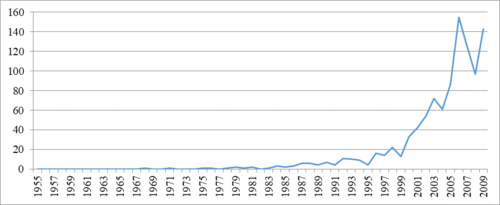
19
There are a number of potential reasons for this stark increase, such as: (1) there is a general societal tendency to use legal means to resolve disputes; (2) there is greater awareness among claimants and lawyers of the existence of, and possibilities under, the ECHR; (3) the Court has broadened the scope of the provisions under the Convention in its case law, so that more and more cases fall under the Convention’s material scope (see also section 8.); and (4) more countries have signed onto the Convention (section 4.). Consequently, the increase in cases before the ECtHR is a general tendency, not particular to Article 8 ECHR, as is shown in Figure 2.
20
Figure 2 Total number of cases compared to the cases on Article 8 ECHR
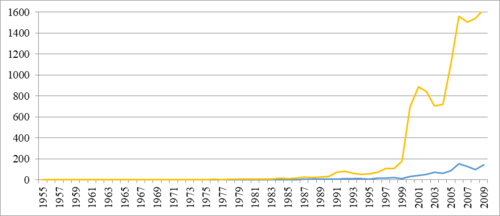
21
What is interesting to see here, is that the Court finds a violation of the right to privacy in a higher percentage of the cases before it over the years. Although until 2000, it held a violation of the right to privacy in about half of the cases under Article 8 ECHR, from the beginning of the new millennium, this has changed significantly, as evidenced by Figure 3 shown below.
22
Figure 3 The judgement of the ECtHR on the point of a violation of Article 8 ECHR
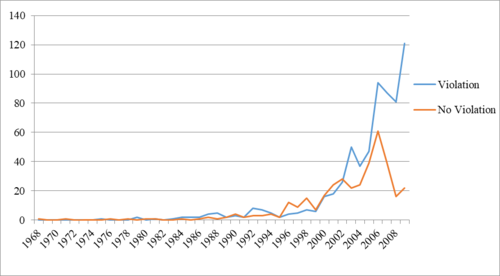
23
Importantly, most cases under the ECHR are combined complaints, either by multiple claimants and/or claims in which multiple provisions under the European Convention on Human Rights are invoked. For example, a claim might be that the government has violated the right to privacy (Article 8 ECHR) and has denied the right to a fair trial (Article 6 ECHR) of Mr. Black. Or, the government has violated the right to privacy of Mr. Black and has denied a right to a fair trial of Mr. Black, his son and his wife, who tried to defend their shared interests in court. Or, the toxic gasses emitted by a power plant violated the right to life (Article 2 ECHR) and the right to private life (Article 8 ECHR) of Mr. Jones, Mrs. Black, Mr. Smith, and 20 others living in the neighbourhood. Consequently, even in cases in which no violation of Article 8 ECHR was found, the Court will often establish a violation of another provision contained in the Convention. In about half of the cases in which Article 8 ECHR was invoked, but not violated, the ECtHR still found a violation of another provision of the European Convention on Human Rights.
24
Figure 4 Percentage of the cases in which another article was violated or not, when Article 8 was assessed on the second tier, but no violation established

25
Importantly, one of the reasons that no violation in a case is found (when in second-tier), is because the case has been struck from the role. Article 37 ECHR specifies with this respect: ‘1. The Court may at any stage of the proceedings decide to strike an application out of its list of cases where the circumstances lead to the conclusion that (a) the applicant does not intend to pursue his application; or (b) the matter has been resolved; or (c) for any other reason established by the Court, it is no longer justified to continue the examination of the application. However, the Court shall continue the examination of the application if respect for human rights as defined in the Convention and the Protocols thereto so requires. 2. The Court may decide to restore an application to its list of cases if it considers that the circumstances justify such a course.’ [24]
26
A case is generally taken from the role if the parties have come to an agreement, particularly when a Member State admits to having violated the Convention and possibly, to award damages. Article 39 ECHR specifies: ‘1. At any stage of the proceedings, the Court may place itself at the disposal of the parties concerned with a view to securing a friendly settlement of the matter on the basis of respect for human rights as defined in the Convention and the Protocols thereto. 2. Proceedings conducted under paragraph 1 shall be confidential. 3. If a friendly settlement is effected, the Court shall strike the case out of its list by means of a decision which shall be confined to a brief statement of the facts and of the solution reached. 4. This decision shall be transmitted to the Committee of Ministers, which shall supervise the execution of the terms of the friendly settlement as set out in the decision.’ [25]
27
Of the 187 cases in which Article 8 ECHR was invoked and no violation of any provision under the Convention was established (not of the right to privacy, nor of any of the other rights under the Convention), 67 were not assessed in substance (even though they were in the second-tier), but struck from the role. Consequently, only in about 10% of the cases submitted to the ECtHR on a potential violation of Article 8 ECHR, the applicants leave empty-handed. [26] This is important because originally, it was thought that the ECmHR (its role was transferred to a chamber of the ECtHR by the 11th Protocol to the Convention) in the admissibility procedure (the first-tier) would filter cases on mainly procedural aspects and the ECtHR would judge in substance (the second-tier) whether a violation of the Convention has occurred. Currently, however, it seems that if a case passes the first-tier, there is a very high chance that a violation of the Convention will be established by the ECtHR. Thus, the real hurdle seems to be the first-tier, not the substantive evaluation of the second-tier.
28
Given the fact that the total number of cases has increased exponentially over the years and added to that, that from 2000 onwards, the ECtHR has held a violation of Article 8 ECHR in a significantly higher percentage of the cases before it, it should not come as a surprise that the majority of the damage that has been awarded by the Court was granted in the last decennium. Especially the ‘Combination’ and the ‘Non-Pecuniary’ damages are high, as is evidenced by Figure 5 below. As will be explained in section 7. in more detail, it is possible for the ECtHR to award pecuniary damages (for material harm), non-pecuniary damages (for immaterial harm), and it can award costs and expenses (for example travel costs or the costs for hiring a lawyer). Sometimes, it combines 2 or more types of damages into one amount (the combination category).
29
Figure 5 Damages awarded in absolute numbers per decennium
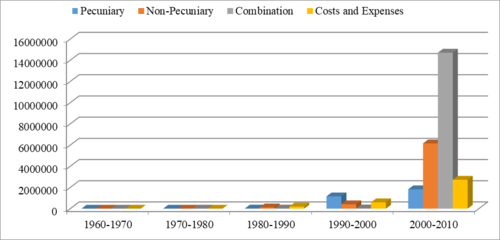
30
What is interesting to see, however, is that the amount of damages awarded per case in which a violation was found is relatively stable, as can been seen in Figure 6. The non-pecuniary damage awarded per case has steadily but slowly increased over time. Perhaps more remarkable is that the costs and expenses awarded by the Court on average per case has dropped in the last decennium. Why this is remains unclear. From the comparison between the last two decennia it appears that the categories ‘pecuniary damage’ and ‘combination of damages’ are communicating vessels. When the pecuniary damages are high, the combination category is relatively low and vice versa. This should not come as a surprise, because both categories are particularly used in the same types of cases; for example, in a country where the homes of the applicants have been destroyed or been made inaccessible or villages have been evacuated by military means, thereby preventing the inhabitants from returning for years. Relatively large sums of money are granted by the ECtHR in these types of cases. Consequently, the larger part of the ‘combination’ category is presumably made up of pecuniary damage.
31
Figure 6 Damages awarded relative to the amount of cases in which a violation was found per decennium
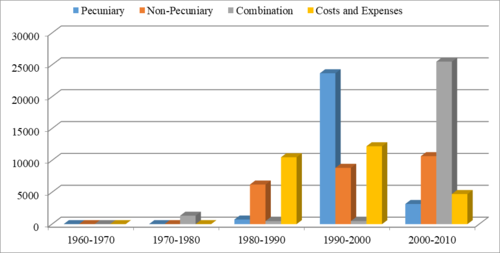
32
The first point of interest is that the number of cases has increased over time. There are a number of obvious and unavoidable reasons for this. The number of states that have joined the Convention has grown substantially, and in general, the population of those countries has grown. In addition, there are certain societal tendencies, such as the increased juridification of society, [27] and the increased awareness of citizens of their rights in general, and of their rights under the European Convention in particular. These have all influenced the case load of the court. What is perhaps more important is that material scope of the rights under the Convention in general and of the right to privacy has grown substantially (see section 8.) – this means that more cases will be declared admissible with respect to a claim regarding Article 8 ECHR. Although the Convention was originally drafted for claims relating to severe human rights infringements, there has been a tendency to increasingly allow claims about infringements of quite ordinary legal doctrines, such as, for example, the portrait right of individuals. [28] This means that the Human Rights Court is increasingly acting as a normal legal court on a European level, and acts increasingly as a court of fourth-instance (complementing the three instances normally provided on a national level).
33
In addition, as pointed out in the results section, the percentage of cases in which a violation is found by the European Court of Human Rights is quite high. The original idea behind the two-tiered system was that in first instance, the ECmHR or after the 11th Protocol entered into force, a separate chamber of the ECtHR, would filter cases on their admissibility. Has the case been submitted out of time? Have all domestic remedies been exhausted? Does the claimant have standing? Has the case already been judged by the ECtHR? These are all mainly procedural aspects, leaving the substantive analysis of the case to the European Court of Human Rights in the second-tier. There is one criterion in the first-tier that touches on the content – cases can be declared inadmissible if the claim is ‘manifestly ill-founded’. [29] Originally, this ground would rarely lead to the inadmissibility of cases. Now, however, it is used more and more by the Court in the first-tier to already do a substantive analysis of the matter before it and reject cases when they do not yield a violation of Article 8 ECHR. [30]
34
Finally, with respect to the damages awarded, three things are clear:
-
Over time, more damage for non-pecuniary harm is awarded to victims. This can in part be explained as a correction for inflation, but not in its entirety. Because the increased number of cases before the Court can in part be explained by the fact that it has opened itself up for claims revolving around more ordinary legal conflicts, the increase of damages can presumably not be explained by the fact that the type of harm inflicted on victims has become more severe over time. The most appealing hypothesis seems that the European Court of Human Rights has shifted its approach, from offering mostly symbolic damages for non-pecuniary harm (as is a tradition in many European countries), towards a more substantial form of compensation.
-
Second, the category of material harm and the ‘combination’ category are communicating vessels. Consequently, it seems logical to presume that most of the damages offered in the combination category actually consist of pecuniary damage.
-
Third and finally, the costs and expenses awarded to victims has dropped in the last decennium analysed for this study. The reason for this is unclear. Have costs dwindled because access to justice is facilitated in the various countries? Has the digitisation of legal procedures had a positive effect on the costs of legal procedures? This could be a topic for further research.
35
The European Convention on Human Rights was adopted in 1950 by a small number of countries. Subsequently, it was ratified in the 1950’s by thirteen states. It was only in the 1970s that a number of bigger European countries, in particular from the south, joined. In the 1990s the ECHR became the standard across Europe, especially because a number of Eastern-European countries joined. There are currently only a handful of European countries that have not ratified the Convention, such as Vatican City, Belarus, and Kazakhstan. It is important to stress, however, that even though countries have ratified the Convention, it is possible for them to make reservations, inter alia, with respect to the authority of the ECtHR. For example, although Turkey signed the Convention in 1954, it was only in 1995 that the ECtHR first assessed a case against Turkey (second-tier).
36
Figure 7 Countries with 10 cases or more on a potential violation of Article 8 ECHR until 2010
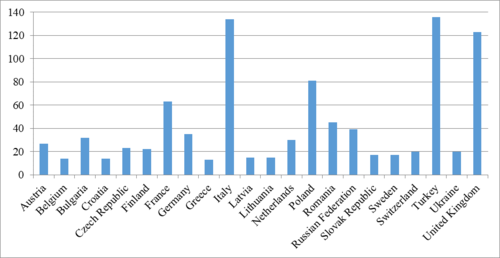
37
What is remarkable is that the majority of the Member States that have signed the Convention have been involved with no, or only a very limited number of cases regarding a potential violation of Article 8 ECHR. The ECtHR has assessed 10 complaints or more about a violation of Article 8 (second-tier) only with respect to 22 of the 47 countries that have ratified the Convention. The other 25 countries have been involved with no, or only a very limited amount of complaints against them regarding a potential violation of the right to privacy. And of these 22 countries, only 10 were involved in more than 30 cases. In fact, it is clear from Figure 7 that a handful of countries are responsible for most cases, namely Italy, Turkey and the United Kingdom, and to a lesser extent Poland and France.
38
Figure 8 Number of cases regarding Article 8 ECHR per country per year
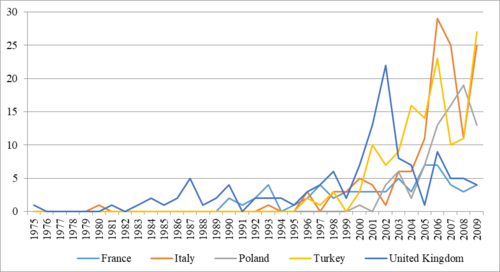
39
Figure 8 shows the number of cases per year with respect to France, Italy, Poland, Turkey, and the United Kingdom. It appears that France has quite a small but steady number of complaints per year, the United Kingdom seems to have peaked, in particular in 2001 and 2002, and that Italy, Poland and Turkey have been involved with cases regarding a potential violation of the right to privacy in particular in the new millennium; the first case ever assessed (second-tier) against Italy being in 1980, against Poland in 2000, and against Turkey in 1996. It is important to emphasize that there is an important difference between these five countries, as is evidenced by Figure 9. While France has not been convicted for a violation of the right to privacy in the majority of the cases lodged against it under Article 8 ECHR, Turkey and the United Kingdom are held in violation for about 50% of cases, and Italy and Poland are held in violation of the Convention in the majority of the cases.
40
Figure 9 Number of cases in which the ECtHR has or has not established a violation of Article 8
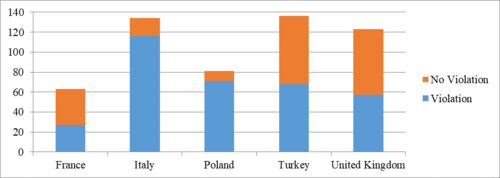
41
There are a number of other countries with a poor track record. Of the 27 cases (second-tier) regarding a potential violation of Article 8 ECHR against Austria, the ECtHR established a violation in 23 of those cases. For Bulgaria, this was 24 of the 32 cases, for Finland 14 of the 22 cases, for Germany 20 of the 35 cases, for Latvia, 12 out of 15, for Lithuania,14 out of 15, for Romania 31 of the 45 cases, for Russia 30 out of 39, and both Switzerland and the Ukraine were held in violation of Article 8 ECHR in 14 of the 20 cases lodged against them under this provision. In fact, 467 of the 647 cases in which the Court has found a violation of Article 8 ECHR (almost 75%), involved either one of these 10 countries: Austria, Bulgaria, France, Germany, Italy, Poland, Romania, Russia, Turkey, and United Kingdom. The remaining 37 countries are responsible for the other 25 % of the violations of Article 8 ECHR.
42
Figure 10 Total amount of damages awarded per category per country
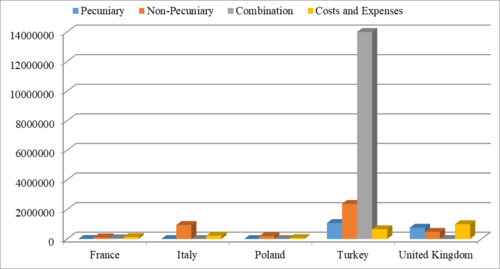
43
If the 5 countries are analysed against which the most cases under Article 8 ECHR were assessed by the European Court of Human Rights, it appears that there exists a significant difference between them. While Poland is the country, which is held in violation of Article 8 ECHR most often after Italy, it is required to pay only minimal damages. Italy is primarily required to compensate non-pecuniary damages, while the United Kingdom has to pay quite significant amounts for both material and immaterial damages, and for the costs and expenses. Turkey is the champion on the point of both material and immaterial costs, and in particular the ‘Combination’ category, the reason for which was already explained above. Figure 10 shows the total amount of damages the countries had to pay in cases in which a violation of Article 8 ECHR was found. Figure 11 shows the total amount of damages per country divided by the number of cases in which a particular country was held in violation of Article 8 ECHR. The category ‘Combination’ in the case of Turkey was € 208.721 on average per case in which the Court considered that it had violated the right to privacy of its citizens (not included in full in figure 11 for reasons of legibility).
44
Figure 11 Total damages awarded divided by amount of cases a country was held in violation of Article 8 ECHR
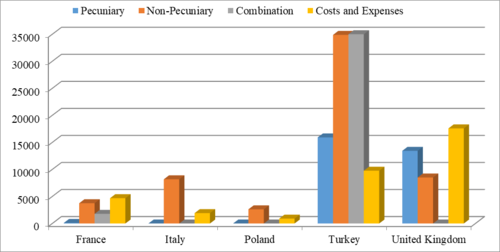
45
From the previous results, three important conclusions may be drawn. First, a number of countries are responsible for by far the most cases before the European Court of Human Rights (second-tier) regarding a potential violation of the right to privacy (Article 8 ECHR). This picture is to a large extent a representation of all cases before the Court, but there are important differences. Turkey is the champion in terms of the number of cases brought against it under the European Convention on Human Rights (with 2296 cases until 2010), followed closely by Italy (2023 cases), and then Russia (863 cases), France (774 cases), Poland (767 cases), Romania (648 cases), Ukraine (608 cases), Greece (558 cases), and the United Kingdom (422 cases). Consequently, the most remarkable feature seems that a relatively large part of the cases against the UK regard a potential violation of privacy (122 of the 422 cases). With Turkey, this is only 128 of the 2296 cases, and for Italy 135 of the 2023 cases, which can be seen as relatively low numbers. Consequently, some countries are involved with a significantly higher percentage of cases on privacy than others. One of the reasons that the United Kingdom may stand out in this respect may be that until late in the previous century, it had quite Victorian policies towards sexual minorities, such as homosexuality and transgender people, and towards non-biological forms of reproduction, such as artificial insemination and surrogate parenthood. Many of the cases against the UK revolve around matters such as homosexuality in the army, BDSM practices, assisted suicide, the protection of transgender people, and the possibility for prisoners to create life through artificial insemination.
46
Second, it appears that some countries are held in violation of the right to privacy in a significantly higher percentage of cases than others. With respect to France, Turkey, and the United Kingdom, cases are declared admissible (first-tier), but no violation is found by the ECtHR (second-tier) in about half of the cases. This means that the questions concerning the matter of the case are considered serious and/or important enough to require a substantial analysis of the Court, allowing it to provide legal guidance to countries, without there necessarily being a violation. An example may be cases revolving around the issue of euthanasia. In Pretty v. the United Kingdom, the case was declared admissible, but no violation was found by the Court. Still, the fact that the case was declared admissible allowed the Court to lay down a legal framework for questions concerning assisted suicide. [31]
47
Finally, it is clear that one country in particular – namely Turkey – is responsible for the majority of damages being awarded in privacy cases before the European Court of Human Rights. This is especially true with respect to the material damages (also part of the ‘combination’ category). Regarding the United Kingdom, most damages are afforded with respect to the costs and expenses – apparently, legal procedures in that country are costly. In the cases of Poland and Italy, on the other hand, the awards for costs and expenses are negligible and most damages are offered with respect to non-pecuniary damages. Apparently, these countries violate the dignitary aspect of privacy more than other countries do.
48
Originally, the Court could convene either in a plenary setting or in a chamber. From 1999 onwards, the second-tier has been dominated by different sections (or chambers) of the Court, namely the first, the second, the third, and the fourth section. In fact, the possibility to judge cases in a plenary setting is now provided for by the possibility of a section to relinquish jurisdiction to the Grand Chamber when a case pending before it raises a serious question affecting the interpretation of the Convention, or where the resolution of a question before the Chamber might have a result inconsistent with a judgment previously delivered by the Court. [32] In 2005, a fifth section has been added. Although there should be no significant difference in how the different sections treat cases revolving around potential privacy violations, there are important variations nevertheless.
49
Figure 12 Amount of cases per setting of the court
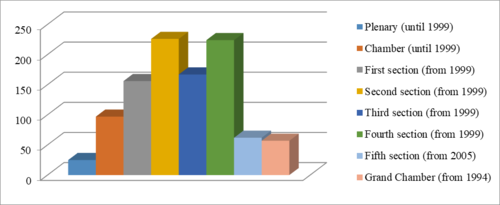
50
Officially, there is no separation of tasks between the different sections. Still, it is remarkable that the second and fourth section seem to deliver significantly more judgements on the question of a violation of Article 8 ECHR than the first and the third section. Maybe this is because there is, in fact, a separation of tasks between the sections. For example, the second chamber has delivered significantly more judgements on the point of family and relational privacy than the other sections. Likewise, the fourth section has delivered 76 out of the 187 cases on informational privacy. Another possibility is that certain sections deliver more judgements on particular countries than others. For example, of the 27 cases against Austria, 16 have been dealt with by the first section. Of the 32 cases against Bulgaria, 28 where dealt with by the fifth section. In a similar fashion, 13 of the 14 cases against Croatia have been dealt with by the first section, etc. It is unclear why this is, but it might have to do with the requirement that one of the judges sitting in the chamber dealing with the cases is of the nationality of the state against which the complaint is lodged. [33] It is remarkable that 22 of the 57 before the Grand Chamber involve a complaint against the United Kingdom.
51
Figure 13 Number of cases a court has assessed a complaint in substance on Article 8 ECHR per country
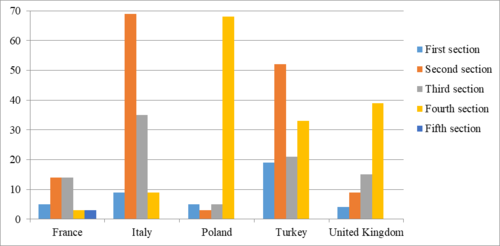
52
The last point that may be interesting in this respect is the percentage of cases in which the different chambers, sections, and courts established a violation. From the early period, it becomes clear that when the court convened in plenary setting, which would typically be in more weighty cases, a far higher percentage of the cases resulted in a violation than when the ECtHR convened in a chamber setting. This is mirrored with respect to the different sections and the Grand Chamber in the later period. In addition, it is also remarkable that especially the first section will find a violation of Article 8 ECHR in a significantly lower percentage of the cases than the other sections. The reason for this remains unclear.
53
Figure 14 Number of cases in which a court a violation was found of the right to privacy
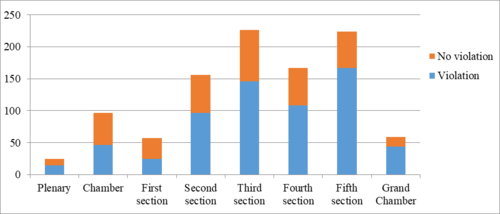
54
Figure 15 Total amount of damages awarded per court
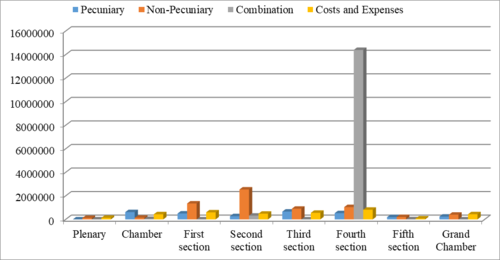
55
Figure 15 shows the total amount of damages awarded per court. It appears that the fourth section has used the ‘Combination’ category in particular; why this is remains unclear. Apart from that, it is clear that especially the first and the second section, and the Grand Chamber attribute higher sums for immaterial damage than the other chambers. From Figure 16, it also appears that the third and fifth section and the Grand Chamber, as opposed to some other sections, have a quite even spread across the pecuniary, non-pecuniary and costs and expenses categories. The average of the ‘Combination’ category per case in which a violation was found by the fourth section is € 86.186,- This graph only goes to € 20.000,- for reasons of legibility.
56
Figure 16 Total amount of damages divided by the number of cases in which a court found a violation
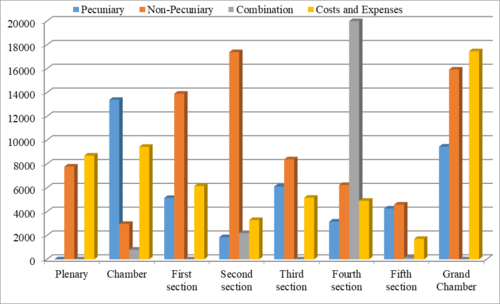
57
It is mostly unclear why these differences between the different chambers and sections of the Court appear. These sections are supposed to be primarily administrative entities. The website of the Court specifies with this respect: ‘A Section is an administrative entity and a Chamber is a judicial formation of the Court within a given Section. The Court has 5 Sections in which Chambers are formed. Each section has a President, a Vice-President and a number of other judges.’ [34] Still, the differences that appear from the statistical analysis provided in section 5.2. cannot be explained by coincidence, or treated as mere insignificant statistical correlations. Consequently, there must be an explanation for the differences in terms of the type of cases that are dealt with by the different sections, the damages awarded, and the country against which the case was brought. This point needs to be investigated in greater detail in future research.
58
Although, the Convention contains the right of a natural person to petition, this represents but a segment of the European supervisory system as a whole. In this respect, it should be noted that an inter-state complaint is not so much concerned with personal harm suffered by one or more natural persons, but focusses rather on general governmental policies, or systematic abuse of state powers. For example, if a government invokes the state of emergency and derogates from the rights and freedoms under the Convention, other states may question the legitimacy or necessity of these actions before the Court. [35] Second, the right to individual petition is open to three types of complainants: individuals, non-governmental organizations (e.g. a municipality or province) and groups of individuals. Consequently, not only can a natural person complain about a violation, a legal body may also claim to be the victim of an interference of its rights. Such an infringement does not revolve around personal harm – rather a church’s freedom of religion may be infringed upon when it is prevented from ringing the church bells in the morning.
59
Moreover, although earlier drafts of the Convention only referred to the right of natural and legal persons to petition, a third category was added, namely any ‘group of individuals’. The right to petition of a group of individuals was inserted to broaden the width of the right to petition and to ensure that no one was excluded from access to the Commission. [36] The term ‘group of individuals’ referred specifically to minority groups, which must be interpreted against the background of the Second World War, in which such groups were stigmatized, discriminated or worse. [37] In such a claim, a group of natural persons does not claim that these persons have suffered themselves specifically and individually from a certain governmental practice – this is already covered by the right of individual petition by natural persons. Rather, a group of individuals has the opportunity to represent the common interests of the minority group as such.
60
Over time, however, the Convention has been revised on a number of points, so that, inter alia, individual complainants (individuals, groups, and legal persons) have direct access to the Court (second-tier) to complain about a violation of their privacy when their case is declared admissible. [38] Moreover, over time, the Court has placed a very large emphasis on individual interests and personal harm if it assesses a case regarding a potential violation of Article 8 ECHR. [39]
61
This focus on individual harm and individual interests brings with it that complaints are declared inadmissible by the European Court of Human Rights if the claimant cannot show that he has suffered from significant harm due to the infringement of his right complained of. By and large, only natural persons are successful in their claims before the Court with respect to their right to privacy, if they have suffered from significant, personal harm. That is why two factors have been analysed for this study. First, the type of applicant and second, the number of applicants.
62
With respect to the types of applicants, a differentiation is made for this study between natural persons and legal persons (individual complaints) and states (inter-state complaints). With respect to the category ‘legal persons’, a somewhat broader take has been adopted, not only listing organizations themselves that have submitted a complaint, but also incorporating those complaints that have been lodged by natural persons when their interests are part of or connected to those of a legal person; for example, their private, one-man firm operated from their home. With respect to natural persons, the category has been further sub-divided between ordinary natural persons and natural persons being prisoners or immigrants. This is because prisoners, by the very nature of their imprisonment, are limited in their rights and freedoms, including their privacy. With respect to immigrants, it is interesting to see whether, and if so, how far these cases differ from other cases, because the idea of human rights is precisely that everyone has them by virtue of being human, independent of nationality. If both a natural and a legal person, an immigrant or a prisoner, submitted a complaint, it was listed under ‘legal person’, ‘immigrant’, or ‘prisoner’.
63
With respect to the number of applicants, although the Court does not allow complaints of groups as groups, it does allow individuals to bundle their individual complaints. Thus, if a group of 50 applicants are all suffering from the same violation, for example, a factory nearby a neighbourhood polluting the area, the ECtHR is willing to accept and bundle their complaints in one case if they can demonstrate that they have all been harmed individually and significantly by the same violation. Five categories have been distinguished for this study; namely, cases in which there was 1 applicant, cases in which there were 2 applicants, cases in which there were between 3 and 10 people involved, cases in which there were between 11 and 50 people involved, and cases in which there were more than 50 applicants. It should be noted that it is often difficult to assess the exact number of applicants. For example, 50 people may lodge a complaint, thereof, 40 people may be declared admissible for their complaint under Article 6 ECHR and 35 under Article 8 ECHR; the Court (second-tier) may then decide that in fact, after a further and more careful assessment, 10 of the applicants complaining about a violation of their right to privacy are actually to be determined under their right to marry and found a family (Article 12 ECHR) and subsequently hold that 15 of the 25 remaining applicants with respect to a potential violation of Article 8 ECHR have indeed suffered from an illegitimate infringement on their right to privacy. Moreover, of those 15 applicants in relation to whom a violation of Article 8 ECHR has been established, 5 of them may be compensated only for the Costs and Expenses, 5 of them for pecuniary or non-pecuniary damages and 5 of them may not been awarded any type of relief. Consequently, there is a margin of error with respect to the numbers and categories below and the results must be taken primarily as indicative.
64
Figure 17 Total number of cases in which a certain number of applicants was involved

65
Figure 17 shows that in fact, by far most cases are brought forward by one person. In cases in which 2-5 applicants are involved, this mostly concerns a family unit, for example when a political refugee is extradited to Iraq and he argues that this would lead to a violation of his right not to be tortured or subjected to degrading treatment (Article 3 ECHR), and his wife and three children claim that his extradition would violate their right to family life (Article 8 ECHR). There seems no significant correlation between the year in which the case was submitted and the number of applicants, for example a sharp rise or fall of the number of applicants over the years – rather, the cases in which more than 10 applicants were involved seem to be spread quite evenly over the years. Figure 18 shows which types of applicants where involved with the cases judged in the second-tier with respect to a potential violation of the right to privacy. It confirms what has been suggested in paragraph 7.1., namely that by far most cases are brought by natural persons, only a small percentage of cases is brought by a company or organisation (note that a governmental organisation cannot submit a claim before the ECtHR – the city of Paris or the province of Andalusia cannot submit an application) and a negligible amount of cases concerns an inter-state complaint.
66
Figure 18 Total number of cases in which a certain type of applicant was involved
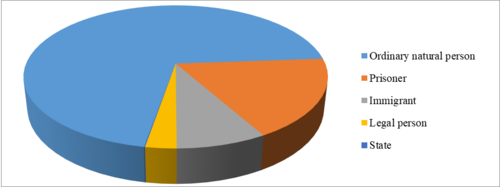
67
Figure 19 shows the total amount of damages that have been awarded by the ECtHR in cases in which a violation was found of Article 8 ECHR until 2010, per category of applicants. Given the very high number of cases in which there was but one applicant, it should not come as a surprise that in this category the most damages have been awarded. What is apparent from the figure too is that the cases against Turkey in which high sums of money were awarded to the applicants have been matters in which larger groups have been involved.
68
Figure 19 Total amount of damages awarded per number of applicants
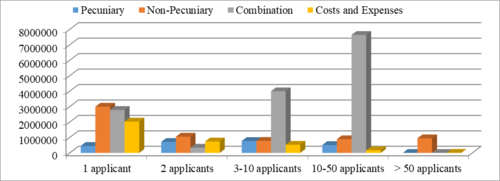
69
Figure 20 shows the average amount of money awarded to the applicants in case a violation was found of Article 8 ECHR in the specified categories. What is remarkable is the quite low numbers of damages. When one applicant was involved, on average, € 896,- was awarded for pecuniary damages per case in which a violation of the right to privacy was established, € 5.906,- for non-pecuniary damages, € 5.488,- in the ‘Combination’ category, and €4.004,- for costs and expenses. When two applicants lodged a complaint which resulted in a violation of Article 8 ECHR, this was on average € 8.385,- for pecuniary and € 12.374,- for non-pecuniary damage, € 3.989,- for the ‘Combination’ category, and € 8.705,- for cost and expenses (meaning in total, for both applicants together). These sums are for the applicants jointly and should consequently be divided by two to calculate the average amount of damages awarded per victim. The more applicants join in a case, on average, the more damage is awarded, which was to be expected. Finally, it should be noted that there are very few cases in which more than 50 applicants have submitted a complaint, so that the results from this category are unreliable.
70
Figure 20 Total damages divided by the number of cases in which a violation was found per category

71
Figure 21 shows the total amount of damages that have been awarded by the ECtHR in cases in which a violation of Article 8 ECHR was established until 2010 per category. It should not come as a surprise that the only relevant category in this respect is that of natural persons.
72
Figure 21 Total amount of damages awarded per type of applicant
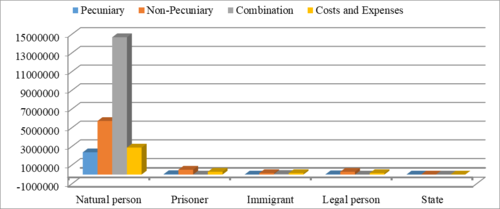
73
Figure 22 shows the total amount of damages awarded per category, divided by the number of cases in which a violation of Article 8 ECHR was found with respect to a certain category. For example, the total amount awarded to natural persons by the ECtHR, divided by the 414 cases in which a violation of the right to privacy of a natural person was found by the Court. What is interesting is that on average, prisoners and immigrants have been awarded limited amounts of damages. This is because in many cases, the ECtHR stresses that the establishment of a violation in itself constitutes sufficient satisfaction for the applicant; for example, by holding that an immigrant should not be extradited, or that a prisoner should have more liberties, for example, with respect to family visits. With regard to legal persons, one could have expected that especially the pecuniary damages and the ‘combination’ category would be high, but the opposite is true. Whether the ECtHR grants non-pecuniary damages to the company or organization itself, or to the owner or other natural persons connected to it, is unclear - further research is needed on this point. Finally, it should be noted that there are very few cases in which inter-state complaints were made, so that the results from this category are unreliable.
74
Figure 22 Total damages divided by the number of cases in which a violation was found per category
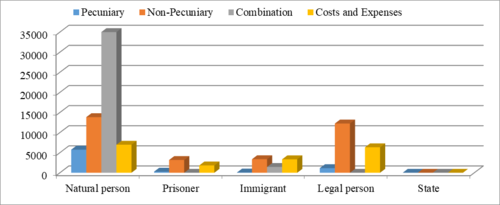
75
The analysis for this section can be quite straightforward. States seldom submit applications, groups are not allowed to submit claims as a group, and legal persons, such as companies, are only marginally successful in invoking the right to privacy under Article 8 of the European Convention on Human Rights. Most of the cases are brought before the Court by natural persons. Some of these are prisoners, some immigrants, but most of them are citizens without a special status or legal position. Most damages that are awarded by the European Court of Human Rights go to natural persons, both in total and on average, which is divided by the number of cases.
76
A point of interest is that the damage being awarded to legal persons mostly falls in the category of non-pecuniary damage. Because the Court is so strict on the fact that privacy is the most personal of all human rights and because it feels that consequently, legal persons can only marginally rely on Article 8 ECHR before the Court, it could have been expected that if the ECtHR would find legal persons admissible in their claim, this would not be related to harm to their personality or other immaterial aspects of the right to privacy. Rather, it would seem logical that the majority of damages awarded to legal persons would have been in the more objective material harms category. The opposite, however, is true, as shown in section 6.2. When the police raid a business premises, the Court is willing to attribute damages for immaterial harm to businesses, which may be rather surprising.
77
With respect to the number of applicants being involved in a privacy case before the European Court of Human Rights, by far most cases are submitted by individual persons, a small part by 2-5 and 5-10 persons, and only a handful of matters are brought to the Court’s attention by a group of 10-50 people or of more than 50 people. Most damages are consequently awarded to individual applicants. When the total amount of damages awarded by the ECtHR in privacy cases is divided by the number of cases per category (1 applicant, 2-5, 5-10, 10-50, or more than 50 applicants), it becomes clear that on average, the ECtHR assigns most damages in cases with 10-50 or more than 50 applicants. However, when the average amount of damages awarded in such cases is divided by the number of applicants, the picture becomes more linear.
78
If the European Court of Human Rights finds a violation of a provision contained in the Convention, it may decide to impose a fine or a sanction. It can hold that a state should stop violating the Convention, that it should abstain from executing its plans (for example, extraditing an immigrant) because that would be in violation of the Convention, or that it should adopt additional policies to prevent others from violating the rights of the applicant (for example, ensuring that the claimants are adequately protected against systematic harassment by third parties). The Court can also impose an obligation on a state to provide financial relief to the claimant. Article 41 of the ECHR holds on this point: ‘If the Court finds that there has been a violation of the Convention or the Protocols thereto, and if the internal law of the High Contracting Party concerned allows only partial reparation to be made, the Court shall, if necessary, afford just satisfaction to the injured party.’ The applicant who wishes to obtain an award of just satisfaction under Article 41 of the Convention must make a specific claim to that effect. It is for the applicant to submit itemized particulars of all claims, together with any relevant supporting documents. [40] The Rules of the Court specify the following about harm and satisfaction.
79
The award of just satisfaction is not an automatic consequence of a violation being found by the ECtHR. The Court will only award such satisfaction if it considers that to be “just” in the circumstances of the case. This means that the particular features of each case are taken into account when making that assessment. Importantly, the Court may decide that the finding of a violation constitutes in itself sufficient satisfaction, without there being a need to afford financial compensation. Indeed, the Court adopts this approach in quite a number of cases, as will be explained later in this article. The Court may also find reasons of equity to award less than the value of the actual damage sustained or the costs and expenses actually incurred. A reason for such a decision may be that the complaint put forth, or the amount of damage, or the level of the costs, is due to the applicant’s own fault. In setting the amount of an award, the Court may also consider the respective positions of the applicant and the Member State, and the local economic circumstances in a country or region.
80
In general, a clear causal link must be established between the damage claimed and the violation alleged. A merely tenuous link between the alleged violation and the damage or speculations as to what might have been when the infringement would not have occurred is not enough. It is important to point out that the purpose of the damages is to compensate the applicant and not to punish the Member State. Three types of damage may be awarded by the ECtHR: pecuniary damage, non-pecuniary damage, and costs and expenses. [41] These three categories are also used in this article when calculating the amount of damages awarded by the Court. One additional category has been added, ‘Combination’, for cases in which the damages are awarded in total, or in respect of a combination of two of these categories. In general, the Court is very explicit on the point of how much damage is awarded per category, but in a handful of cases, it has stressed that it is unable to determine the damages precisely and that it will consider that, for example, the material and immaterial damages taken together amount to a certain sum.
-
About awarding pecuniary damage, the Rules of the Court make clear that the principle is that the applicant should be placed, to the extent possible, in the position in which he would have been had the violation found not taken place (restitutio in integrum). This can involve compensation for both loss actually suffered (damnum emergens) and loss, or diminished gain, to be expected in the future (lucrum cessans). [42] Normally, the Court’s award will reflect the full calculated amount of the damage, but if the actual damage cannot be precisely calculated, the Court will make an estimate based on the facts and circumstances of the case.
-
On the aspect of awarding non-pecuniary damage, the Rules of the Court emphasize that this is intended to provide financial compensation for non-material harm, for example, mental or physical suffering. Applicants who wish to be compensated for non-pecuniary damage can specify a sum, which in their view would be equitable. Importantly, applicants who consider themselves victims of more than one violation may claim either a single lump sum covering all alleged violations, or a separate sum in respect of each alleged violation.
-
Finally, awarding money for costs and expenses is intended to compensate for the applicant’s travel costs, costs for lawyers, and possibly for other expenditures related to the legal proceedings themselves. The Rules of the Court specify on this point that the Court can order the reimbursement to the applicant of costs and expenses, which he has incurred – first at the domestic level, and subsequently in the proceedings before the Court itself – in trying to prevent the violation from occurring, or in trying to obtain redress therefor. Importantly, costs and expenses must have been necessarily incurred, meaning that they must have become unavoidable in order to prevent the violation or obtain redress therefor. They must be reasonable as to quantum. [43]
81
In this study, the amounts awarded by the ECtHR have been calculated in Euros. After the introduction of the Euro, the Court has (with a few exceptions) used the Euro as its standard currency, even for applicants from countries that have a different currency. [44] However, the Euro was introduced virtually in 1999 and in notes and coins in 2002; in cases before 2002, the ECtHR used the currency of the state against which a violation was found. These sums have been converted into Euros using the fixed conversion rates as established by the EU for countries joining the Euro-group; [45] for other currencies, a fixed conversion rate has been set too for the purposes of this study. [46] Choosing a fixed conversion rate means that no account is taken of the fluctuations in currencies. Although for most countries these are relatively stable, some countries, such as Italy, have historically devaluated their currency a number of times, so that picking one fixed rate may give a somewhat distorted picture. Other methodological choices that have been made for this study are:
-
Only the cases in which Article 8 ECHR was violated are included with respect to the damages; cases in which no violation was found, but in which the Court did award damages in relation to a violation of another provision, are not included with respect of the damages. This may occur when a complaint regards both a violation of Article 6 ECHR (fair trial) and Article 8 ECHR, but the court found only a violation of Article 6 ECHR and not of the right to privacy.
-
In cases in which a violation of Article 8 ECHR was found, all damages have been included, even if a violation of more provisions was established. Thus, if the court finds both a violation of Article 6 ECHR and of Article 8 ECHR and awards damages, the total amount of damages are taken into account. The reason for this is that the ECtHR usually awards a total sum for the violations, without differentiating the amount of damages awarded for a violation of Article 8 ECHR and for a violation of another provision.
-
When awarding damages for costs and expenses, the ECtHR usually grants a total sum and makes clear that the relief the applicants received via other means must be deducted from that sum; in this study, the total sum is included, because it is mostly unclear whether applicants received relief through other means and if so, how large the sum was that they received.
-
In some cases, the Court stresses that it will calculate the damages to be awarded in a separate decision, but sometimes, the parties have reached a settlement on the compensation before that judgement. These damages are not taken into account, because the amounts agreed upon are usually not disclosed to the public.
-
The Court often underlines that interest rates should be taken into account, if the country does not pay the damages within the period specified by the Court. These rates have not been taken into account, because it is usually impossible to find out whether the country did pay the damages on time or not.
-
Sometimes, the Court stresses that if a country executes a certain policy, it would act in violation of the ECHR and that if it would go on to execute the policy, it would need to pay damages. These damages have also been taken into account, although it is unclear whether the country has indeed executed its policy or not and thus had to pay damages. [47]
82
Figure 23 shows the total amount of damages the ECtHR has awarded for a violation of the right to privacy in cases until 2010 per category. In total, € 3.001.222,- has been awarded in respect of pecuniary damages. With regard to non-pecuniary damages, this was € 6.689.578,- and € 14.757.151,- was the total amount of euros afforded by the ECtHR to claimants in an unspecified manner (combination category). Finally, € 3.526.334,- was awarded in total for cost and expenses. Divided by the number of cases in which a violation was found of Article 8 ECHR, this means that on average, € 4.632,- for pecuniary damage, € 10.323,- for non-pecuniary damage, € 22.773,- for a combination of categories, and € 5442,- for costs and expenses have been awarded per case. This is remarkable because the ECtHR has only used the category of combined costs in about 20 cases, while it has awarded non-pecuniary damages and awards for costs and expenses in almost 400 cases. In only 38 cases it has granted pecuniary damages.
83
Figure 23 Total amount of Euros awarded in cases in which a violation of Article 8 ECHR was found

84
In most cases in which it finds a violation of Article 8 ECHR, the Court awards damages for non-pecuniary and/or for costs and expenses, but these are normally relatively small amounts. In a small number of cases, it will award either pecuniary damage or a combination of different types of damages (mostly including material damage) – in these cases, the amount of damages awarded is typically higher. This is evidently true for the combination of damages, but also for the pecuniary damages. Although the Court has awarded about two times more for non-pecuniary damage than for pecuniary damages in total, the number of cases in which it awarded non-pecuniary damage is about 10 times higher. Finally, it is interesting to note that of the 648 cases in which the Court has found a violation of Article 8 ECHR, it awarded some type of relief only in 564 of them and in 440 of the cases, when the mere procedural costs (the awards for costs and expenses) are excluded.
85
Figure 24 Number of cases in which the Court has awarded damages in a certain category
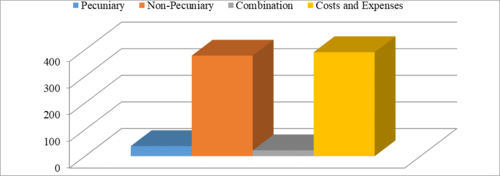
86
The character of privacy as a human right, protecting a person against violations related to human dignity, [48] is confirmed by the figures found for this study. In almost two thirds of the cases in which the European Court of Human Rights has found a violation of the right to privacy (Article 8 ECHR), it has awarded some form of non-pecuniary damages for immaterial harm. Per case in which some form of immaterial harm was compensated by the ECtHR, an average sum of about € 16.000 was awarded. Although this may be a low number when compared to American standards, for European standards, it is quite reasonable or even towards the higher end. One of the reasons for this may be that the European Court of Human Rights is used only if the national remedies have been exhausted. [49] This means that in principle, a claim before the ECtHR will only be declared admissible if the claimant has applied to a court, a court of appeal, and the supreme court, before the claim will be received before the ECtHR. In general, only the victims of more serious claims will take the effort of legal litigation, which could take years. In addition, the human rights courts in principle only accept cases in which significant harm is inflicted to the victim. [50] Human rights under the ECHR lay down the minimum requirements of respect for human dignity, meaning that most legal cases will not qualify as falling under the material scope of the European Convention on Human Rights in general and the right to privacy in particular.
87
Only in about 60 if the 648 cases in which the ECtHR has found a violation of Article 8 ECHR has it provided damages for material harm or a combination of harms, including material harm. This means that in general, the right to privacy is not focussed on material losses. Still, the cases in which it finds that pecuniary damage has been inflicted, the European Court of Human Rights awards high sums of money to the victims. Consequently, when material harm is accepted by the Court to have led to a violation of a person’s privacy, the infringement on the right to privacy is quite severe. As will be shown below, a typical example of such a case is one in which the army of a certain country destroys a whole village, or when villages are evacuated for a long period of time. The residents then typically bundle their claims, so that one case is brought by a group of victims, which obviously has an impact on the amount of damages awarded.
88
Categorizing the cases under the right to privacy, Article 8 ECHR, is very difficult for a number of reasons. First, the ECtHR has chosen a very wide and broad interpretation of the different concepts provided protection under this provision: ‘private life’, ‘family life’, ‘home’, and ‘correspondence’. [51] To provide an example, ‘correspondence’ not only refers to letters or telephony, but also modern forms and means of communication. ‘Home’ is not only the home of an individual, but any premises in which a person lives on a quasi-permanent basis, with factories, office buildings and restaurants also possibly qualifying as the ‘home’ of a legal person. A ‘family’ relation not only exists between a married couple and their children, but can, depending on the circumstances of the case, also exist between grand-children and grand-parents, between non-biological parents and children, between children and great-uncles, and between children and a mentor or supervisor. Finally, ‘private life’ has been used as a term that may include almost anything that remotely relates to a person’s identity or personal development.
89
Second, the original rationale behind the right to privacy was granting the citizen negative freedom in vertical relations, that is the right to be free from arbitrary interferences by the state. In this line, the Court still holds that the ‘essential object of Article 8 is to protect the individual against arbitrary action by the public authorities’. [52] However, the Court has gradually diverged from the original approach of the Convention authors by accepting both positive obligations for national states and granting a right to positive freedom to individuals under the right to privacy. The element of positive liberty was adopted quite early in a case from 1976: ‘For numerous anglo-saxon and French authors the right to respect for "private life" is the right to privacy, the right to live, as far as one wishes, protected from publicity. [H]owever, the right to respect for private life does not end there. It comprises also, to a certain degree, the right to establish and to develop relationships with other human beings, especially in the emotional field for the development and fulfillment of one's own personality.’ [53] Likewise, from very early on, the Court has broken with the strictly limited focus of the authors of the Convention on negative obligations (the obligation not to use power in certain ways) and has accepted that states may under certain circumstances be under a positive obligation (the obligation to use power in certain ways) to ensure respect for the Convention. This has had an enormous impact on both the underlying rationales and the material scope of the right to privacy under the European Convention on Human Rights.
90
Third, the European Court of Human Rights, when discussing cases under the right to privacy, Article 8 ECHR, is often vague about the question of which of the four terms contained in the provision applies to a certain case. Often, it combines two terms, for example stressing that a certain matter affected the applicant’s ‘private and family life’ or his ‘private life and home’. Sometimes, the ECtHR merely points out that the case clearly fell ‘under the scope of the right to privacy’, or that it was not disputed by any of the parties involved that the cases were to be discussed under the right to ‘private and family life, home and correspondence.’ In some cases, the Court simply ignores the question of whether a case falls under the scope of Article 8 ECHR and sometimes, it clearly avoids it by underlining that ‘even if the case fell under the scope of the right to privacy’, it must, for example, be rejected because the infringement was prescribed for by law and necessary in a democratic society. This attitude of the Court makes it very difficult to categorize the cases with respect to the type of privacy that is at stake.
91
Fourth, the Court has often stressed that the Convention and its Protocols must be seen as a whole. This means that a number of rights and freedoms that are protected by other provisions of the Convention, are sometimes included under the scope of the right to privacy. For example, the right to marry and found a family, as protected under Article 12 ECHR, is in fact mostly ignored by the Court; instead, questions revolving around, for example, gay marriage and in vitro fertilization are discussed under Article 8 ECHR. Though the right to a fair trial is incorporated in Article 6 ECHR, the ECtHR has made clear that there are also procedural safeguards implicit in the right to privacy, so that a right to a fair trial is also protected under Article 8 ECHR. Although one’s bodily and psychological integrity is protected by Articles 2, 3 and 4 ECHR, the ECtHR has treated cases revolving around these types of question primarily under the right to privacy. Although the right to reputation was explicitly excluded from the right to privacy, and moved to paragraph 2 of Article 10 ECHR, concerning the right to freedom of expression, the Court has nevertheless underlined that the right to reputation shall be protected under Article 8 ECHR. Consequently, the realm of the right to privacy has been expanded quite considerably.
92
Fifth and finally, the ECtHR has introduced the ‘living instrument’ theory when interpreting the Convention. This means that the Court is at liberty to interpret the Convention according to its views in light of current societal tendencies and developments, and to introduce new rights and freedoms under the existing provisions in the Convention. Perhaps quite unsurprisingly, it is primarily article 8 ECHR that has functioned as umbrella for these new rights and freedoms. It is beyond the scope of this paper to discuss these matters in detail, [54] but in general it can be established that the underlying rationale has moved from obligations on states not to abuse their power, to individual and subjective rights of natural persons to protect their individual autonomy, their human dignity, and their personal freedom. Almost everything that is even only remotely connected to personal interests is accepted under the material scope of the right to privacy. For example, the ECtHR has stressed that Article 8 also provides protection to the right to develop one’s sexual, relational and minority identity, the right to personal development, the right of foreigners to a legalized stay, the right to property and even work, the right to environmental protection, the right to have a fair and equal chance in custody cases, a right to data protection, the right to a name and/or to change one’s name, etc. In terms of material scope, the right to privacy has become by far the largest doctrine protected under the European Convention on Human Rights.
93
Because the scope of Article 8 ECHR has become so broad, this study started by identifying 10 categories: (1) Matters relating to bodily and psychological integrity; (2) family and relational privacy; (3) communicational secrecy; (4) home and locational privacy; (5) protection of honour and reputation; (6) cases on data protection; (7) cases on (mass) surveillance; (8) cases on environmental protection and the right to a healthy living environment; (9) matters in which broader issues relating personality, identity, and personal development were at stake; (10) questions in which the enjoyment of property or primarily economical aspects were discussed. Because it proved impossible to do a reliable analysis on the basis of 10 categories, these have been scaled back to 5 categories. The protection of honour and reputation, cases which concerned the healthy living environment of individuals, and the broader questions regarding personality and identity have all been included in the first category; cases on data protection and mass surveillance have been combined with the category on communicational secrecy; this category is now coined ‘informational privacy’.
94
Consequently, five categories are used in this study. The choice of categorizing a case in one or another group is often difficult and to some extent arbitrary. Importantly, there are cases in which there are two separate complaints on the right to privacy; for example, the government has wire-tapped a person’s telephone in violation of his informational privacy and has subsequently decided to enter and search that person’s house without a warrant, in violation of his locational privacy. In cases in which both complaints lead to a violation or in which both complaints were rejected by the ECtHR, it has been decided to categorize the cases under the category that seemed most important/prominent. Again, these choices are to some extent arbitrary. If one part of the complaint, for example the part on the telephone tap, resulted in the Court’s consideration that the government did not act in violation of Article 8 ECHR, but that it did violate the applicant’s right to privacy because the house search was not prescribed for by law, the case has been categorized under the type of privacy in which the violation was established. This is because if damages were awarded by the ECtHR, this would be linked to the corresponding privacy category.
95
The five privacy types now distinguished are:
-
Bodily and psychological integrity: this is presumably the broadest of the five remaining categories. It includes, inter alia, cases on one’s sexual freedom, for example of homosexuals not to be prosecuted and criminalized; [55] transgender people demanding full recognition of their new gender, inter alia in government documents; the right not to be involuntarily subjected to medical treatment; the right to change one’s name; the right to reputational protection; the right to a healthy living environment.
-
Relational privacy: this category is used for all cases that related to the possibility of a person to engage with others and to develop relationships. Most prominently, this category contains cases about children being placed out of home, custody cases and visiting rights by parents. Importantly, when a person complains that he is unable to communicate with others, for example a prisoner being prevented from sending letters to his family, this is categorized as relational privacy; when the complaint was about the authorities reading the letters, this is categorized as informational privacy.
-
Informational privacy: this category consists of a combination between different, though related types of cases. It contains matters regarding modern types of surveillance, such as mass surveillance by intelligence services or camera-surveillance through the use of CCTV-cameras. The category also incorporates classic data protection cases, such as people wanting access to documents and information relating to them stored by the government. It also contains cases on communicational secrecy, such as wiretapping telephone conversations by the state; an important part of this category consists of cases in which prisoners complain that their letters are opened and censored by the prison authorities.
-
Locational privacy: this category consists of cases in which the government accesses the private home of an individual. In addition, the ECtHR has sometimes allowed legal persons an analogous claim, for example, when the police have searched the premises of a company in relation to tax evasion.
-
Economical privacy: while the previous four categories may be seen as linked to or as an expansion of the four terms listed in Article 8 ECHR (private life, family life, home and correspondence), a fifth category is newly introduced by this study. It incorporates cases which revolved primarily around the enjoyment of property and/or economical aspects. For example, there are cases under Article 8 ECHR in which the homes of individuals are destroyed; this is not, in the classic sense, a violation of the locational privacy of individual, because it does not involve entering the home or gathering private information, but primarily relates to the loss of property. Similarly, this category includes cases on the right to inherit family assets by bastard children and the special tax status for unmarried couples compared to married couples. It also includes cases on the inability to get a job in the army, because it has a policy of rejecting openly gay people.
96
Figure 25 Total number of cases per category
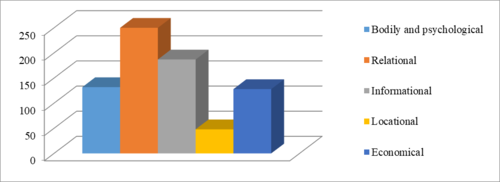
97
Figure 25 shows the total number of cases that have been assessed by the ECtHR (second-tier) until 2010 under the right to privacy, Article 8 ECHR. It is clear that the second category, the right to relational privacy, is the category with the highest number of cases - almost 300, followed by the right to informational privacy, with nearly 190 cases. Interestingly, although the first category is by far the broadest in material scope, it contains a modest number of cases; like bodily and psychological integrity, there are around 130 cases in which the enjoyment of property or economical aspects are central aspects.
98
With respect to the latter category, this might be qualified as a high number, as there has been considerable discussion on this point by the authors of the Convention. First, when drafting the Convention, it was discussed at length whether a separate provision should be included on the enjoyment of property, and second, whether Article 8 should make explicit mention of the right to protection of personal property. The authors of the Convention made a conscious decision to exclude the protection of economic interests explicitly from the Convention as a whole and the right to privacy in particular. One of the reasons being that the protection of property is a socio-economic or a so called second generation right, while the European Convention on Human Rights only contains civil and political rights, or so called first generation rights. The socio-economic rights have been transferred to a protocol to the Convention, the ratifying of which was an option. [56] As is apparent from Figure 25, the ECtHR has made a decision to include cases with respect to the protection of personal property, economic affairs and financial protection under the Convention and the right to privacy nevertheless.
99
Finally, it is interesting to see that there are very few cases on the potential violation of locational privacy, even though this also includes cases in which the office of a company was entered by governmental officials. There are less than 50 cases on this point. On the one hand, this may be considered remarkable because the protection of the home is perhaps the classic aspect of the right to privacy. On the other hand, precisely of this reason, governments might be more hesitant to infringe on the privacy of citizens than they are with respect to, for example, communication over the internet. An additional consideration in this respect may be that in many countries, there is a well-established doctrine providing special protection to the home, often dating back several centuries. Consequently, restraint towards entering the home is often embedded in the legal as well as social practice in a country. This may be an explanation for the low number of cases regarding the locational privacy of citizens, but there may be others.
100
Figure 26 Total number of cases per category per year
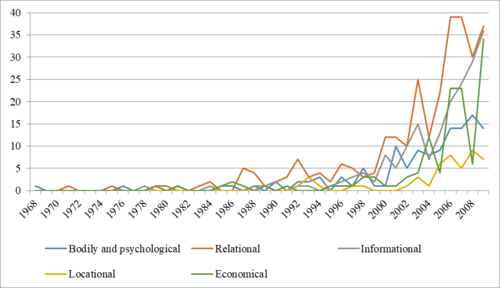
101
Figure 26 shows the total number of cases per category per year. From this graphic, it is apparent that relational privacy has always been the dominant category in the case law of the ECtHR. However, it is also clear that informational and economic privacy are becoming especially important in the latter years. The increase in cases on informational privacy may be correlated with the increased focus on surveillance in light of terrorist attacks, but more research is needed on this point. Why economic privacy has become more important over the years is unclear.
102
Figure 27 Times a violation was or was not found per category
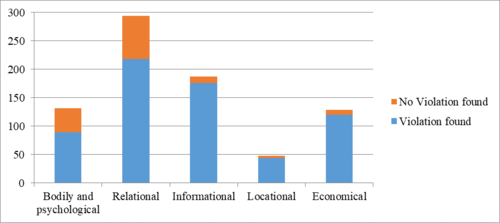
103
What appears from Figure 27 is that there is a sharp contrast between the five types of privacy with respect to the percentage of cases on Article 8 ECHR (second-tier) in which a violation is found. If a case is declared admissible on the point of informational, locational or economic privacy, it is almost certain that a violation will be found. With respect to bodily and psychological integrity and relational privacy, about one out of three or one out of four cases will get rejected.
104
Figure 28 Number of cases per category in relation to five countries
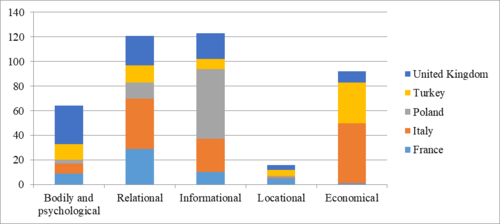
105
Figure 28 shows the number of cases in the different categories, in relation to the five countries against which most cases were assessed by the Court on the point of a potential violation of the right to privacy. What appears is that particular countries have been involved with cases on certain types of privacy significantly more than others. The United Kingdom is primarily responsible for the cases on the point of bodily and psychological integrity. This may be due to the fact that in the recent past, it had quite strict laws on homosexual practices, and medical-ethical issues, as underlined in a previous section. Italy is prominent in cases on relational and economic privacy, France is almost absent in the category of economic privacy and is primarily represented in the figures on relational privacy. Turkey, as has been stressed a number of times, has had quite a number of cases against it regarding the point of the enjoyment of property, and the cases against Poland relate almost entirely on the point of informational privacy.
106
Figure 29 Number of cases per category in relation to the number of applicants
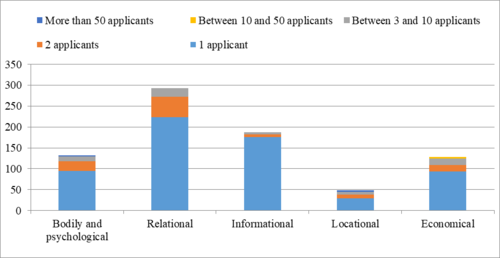
107
From Figure 29, it appears that especially with respect to relational privacy, there are quite a number of cases in which small groups of 2-10 people submit a complaint. These would typically be family units. With respect to informational privacy, cases are almost exclusively lodged by individuals. The other categories have a more equal division in terms of number of applicants.
108
Figure 30 Number of cases per category in relation to the type of applicant
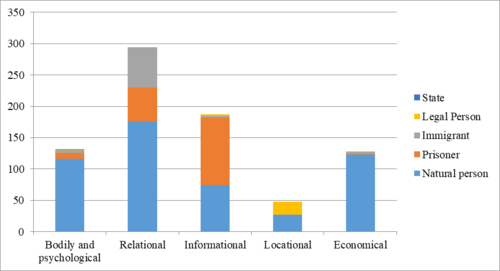
109
Figure 30 shows that prisoners complain almost exclusively about a violation of their relational and informational privacy. These cases typically revolve around either their correspondence being monitored and opened, or around the fact that they are denied contact with others, such as family members, either in real life (visits) or by corresponding with them. Immigrants complain almost exclusively about a violation of their family life. The typical application here would be the claim that if a person gets extradited, this would tear him apart from his family living in that country, which would result in a violation of Article 8 ECHR. This is interesting, because the ECtHR has consistently held that this claim is much stronger than the claim that an extradition would lead to the violation of a person’s private life, in the sense that his life, work, friends, future, etc., that he has in a particular country, would be disrupted. Finally, with respect to legal persons, it is clear that these cases are almost exclusively about governmental officials entering their premises.
110
Figure 31 Total amount of damage awarded per category
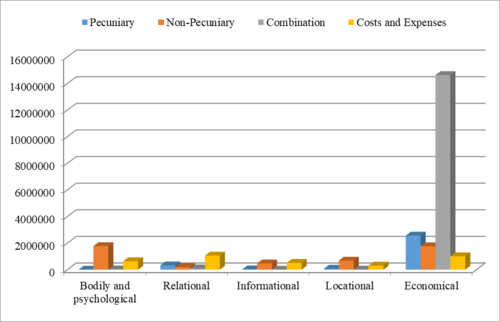
111
Figure 31 shows the total amount of damages that have been awarded by the Court until 2010 in cases in which it has found a violation of Article 8 ECHR. Obviously, the category of economical privacy represents the highest figures, though immaterial damages are also substantial when a government has invaded a person’s bodily or psychological integrity.
112
Figure 32 Average amount of damage awarded per case in which a violation of a category was found
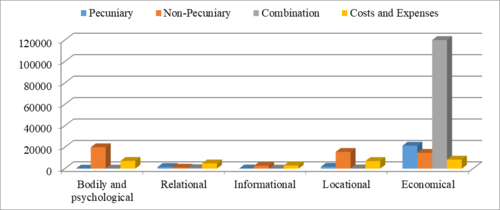
113
Figure 32 has divided the total sum per category by the number of cases in which the ECtHR has established a violation of that type of privacy. Most damages have been awarded for a violation of economic privacy. Judging from the amount of damages awarded in the other four categories, it seems that the Court is inclined to provide higher sums of damages for a violation of a person’s bodily or psychological integrity and for an infringement on the privacy of his home, than for a violation of relational or informational privacy. Hypothetically, the cause could be that in those types of cases, the Court holds that the establishment of the violation itself provides sufficient satisfaction, for example stressing that prison authorities cannot monitor all correspondence of prisoners or that a parent was wrongly denied access to his children. However, although this indeed holds true for informational privacy, such a finding by the Court is no more frequent regarding respect to relational privacy than in relation to bodily and psychological, locational and economic privacy. Out of the 89 cases in which the ECtHR found a violation of Article 8 ECHR with respect to bodily and psychological integrity, in 20 it provided no relief for damages or compensated only the legal costs in the Costs and Expenses category; for relational privacy, this was 60 out of 218 cases; for informational privacy, this was 73 out of 176; for locational privacy, this was 10 out of 44; and finally, for economic privacy this was 45 out of 120 cases. Consequently, the explanation must be that with respect to relational privacy, the ECtHR does provide damages, but only small sums.
114
Five types of privacy have been distinguished. The results from the statistics show that each category has its own characteristics.
-
Bodily and Psychological Integrity: This category revolves around cases regarding sexual freedom, medical-ethical questions and harm to one’s identity and reputation. It is clear from the figures that the majority of cases that regard this type of privacy are brought against the United Kingdom, the reason for which has been explained in section 4. Not surprisingly, relatively high sums of damages are awarded by the European Court of Human Rights in this category when it comes to non-pecuniary damage. In contrast to cases with respect to informational, locational and economical privacy, in a relatively substantive part of the cases judged by the ECtHR (second-tier) on the aspect of bodily and psychological integrity, no violation of privacy was found. As explained, because these cases are so essential to human dignity, there is restraint in the first-tier to declare such cases inadmissible. In addition, even if there is no violation of Article 8 ECHR in such cases, the European Court of Human Rights can take the opportunity to lay down a framework or guidelines on these aspects of privacy.
-
Relational Privacy: Most cases with respect to the right to privacy under the Convention concern the relational aspect; in general, these cases relate to contact with family members. A substantial part of these cases concern prisoners, who claim the prison regimes disable them from seeing their children and/or lovers. Almost all cases that are filed by immigrants revolve around this category of privacy. Typically, it involves an immigrant being extradited, claiming that this would harm the family life that person has built in a certain country. Remarkably, although the European Court of Human Rights often stresses that family life, and in particular the right of parents to have access to their children, is the most fundamental aspect of the right to privacy, the damages provided in this category are relatively low. One of the reasons for this might be that the Court finds that the decision itself provides sufficient relief, for example by ruling that the immigrant in question cannot be extradited or that the prisoner should be allowed to have contact with his family. This needs to be subject of further research. In contrast to cases with respect to informational, locational and economical privacy, in a relatively substantive part of the cases judged by the ECtHR (second-tier), no violation of privacy was found.
-
Informational Privacy: The majority of the claims about informational privacy aspects are brought by prisoners. Cases typically involve prison authorities checking mail, either analogous or digital, and filtering messages. The ECtHR has stressed that this is only allowed under specific circumstances, and most importantly, must have a basis in law. Although there is a relatively large amount of cases regarding informational privacy, in general, low amounts of damages are awarded to victims. Poland is the country against which this type of privacy is invoked the most. Almost all cases judged by the Court (second-tier) with respect to this aspect of privacy lead to the conclusion that there has been a violation of Article 8 ECHR.
-
Locational Privacy: The invasion of the home or private property is the aspect of privacy least brought forth before the European Court of Human Rights (or rather, declared admissible). This may be because these types of privacy violations seldom occur. Alternatively, a reason could be that the state only enters the home of a citizen when it is absolutely certain that this is necessary and is provided for in law. An interesting point is that a relatively high amount of damages are awarded in this category for immaterial harm, that is, non-pecuniary damages. Apparently, the home is essential to human flourishing. Finally, almost all cases submitted by legal persons are in this category; such cases typically revolve around the claim that government authorities have illegally entered the business premises of a company. Almost all cases judged by the Court (second-tier) with respect to this aspect of privacy lead to the conclusion that there has been a violation of Article 8 ECHR.
-
Economical Privacy: Economical privacy is a category not directly embedded in Article 8 ECHR. Although the authors of the European Convention on Human Rights explicitly chose to reject concerns over property and financial loss from the Convention as a whole and the right to privacy in particular, the ECtHR has gradually decided to bring such matters under the scope of Article 8 ECHR nevertheless. These cases are brought primarily against Italy and Turkey. There are relatively few of such cases before the European Court of Human Rights, but those that do get accepted are important in terms of damages being awarded. Compensation is primarily provided in the ‘combination’ category, which must be presumed to be made up primarily by material harm. Almost all cases judged by the Court (second-tier) with respect to this aspect of privacy lead to the consideration that there has been a violation of Article 8 ECHR.
115
The right to privacy under the European Convention on Human Rights is a so-called qualified right. This means that Article 8 ECHR specifies under which conditions the right can be legitimately curtailed by the government; these conditions are listed in paragraph 2 of Article 8 ECHR, which specifies: ‘There shall be no interference by a public authority with the exercise of this right except such as is in accordance with the law and is necessary in a democratic society in the interests of national security, public safety or the economic wellbeing of the country, for the prevention of disorder or crime, for the protection of health or morals, or for the protection of the rights and freedoms of others.’ Consequently, if the government infringes on a person’s privacy, for example by entering his home, this need not be illegitimate or a violation of his privacy. The infringement can be deemed in harmony with the European Convention on Human rights when it abides by three cumulative requirements: (1) the infringement must have a legal basis; (2) must serve one of the legitimate goals as listed in the second paragraph of Article 8 ECHR; and (3) must be necessary in a democratic society.
116
Of the cases assessed by the ECtHR in the second-tier, there may be a number of reasons why no violation of Article 8 ECHR is found. For example, because the Court finds that a case has been wrongfully declared admissible, because a settlement has been reached by the parties in the meantime and the case needs to be struck from the list, or because a violation of another provision under the Convention has been established, and the Court finds it unnecessary to determine whether there has also been a separate violation of the right to privacy (the ECtHR may, for example, hold that in a case, a person’s right to freedom from torture (Article 3 ECHR) had been violated and find it unnecessary to analyse to what extent the torture also violated a person’s right to privacy). These are preliminary and procedural reasons. Alternatively, the ECtHR may find that although there has been an infringement of the right to privacy (as provided in paragraph 1 of Article 8 ECHR), this was a legitimate one and thus not in violation of Article 8 ECHR. The ECtHR only reaches this conclusion if all three requirements (legal basis, legitimate aim, necessary) have been fulfilled; if the government fails to fulfil either one of these requirements, a violation of the right to privacy will be found.
117
The Court may find that an infringement was not prescribed for by law for a number of reasons – the ‘law’, in this sense, is always the national law of a country. The ECtHR uses a quite wide definition of law, it includes not only legislation, but also judge-made law typical of common law jurisdictions and secondary sources, such as royal decrees and internal regulations. [57] First, a violation of the Convention will be found on this point if the actions of governmental officials are not based on a legal provision granting them the authority to act in the way they did. Second, a violation will be established if the conditions as specified in the law for using certain authority have not been complied with, for example, if police officials have no warrant for entering the home of a citizen. Third, the actions of the governmental officials may be prescribed for by law, but the law itself may not be sufficiently accessible to the public. Fourth, the law may be so vague that the consequences of it may not be sufficiently foreseeable for ordinary citizens. Fifth and finally, the ECtHR has in recent years developed an additional ground, namely that the law on which actions are based does not contain sufficient safeguards against the abuse of power by the government. This typically applies to laws authorizing mass surveillance activities by intelligence agencies that set virtually no limits on their capacities, specify no possibilities for oversight by (quasi-) judicial bodies, and grant no or very limited rights to individuals, with respect to redress. [58]
118
The Court may also find a violation of Article 8 ECHR if the infringement serves no legitimate aim. [59] The second paragraph specifies a number of legitimate aims, primarily having to do with security related aspects, such as national security, public safety, and the prevention of crime and disorder. These terms are sometimes used interchangeably by the Court, but in general ‘national security’ is applied in more weighty cases than ‘public safety’, and ‘public safety’ in more weighty cases than the ‘prevention of crime and disorder’. The right of privacy may also be legitimately curtailed to protect the rights and freedoms of third parties; for example, a child may be placed out of home (an infringement on the right to family life of the parents), because the parents sexually molested the child. The protection of health and morals may be invoked to curtail the right to privacy, though this category is applied hesitantly by the ECtHR, because the protection of the morals of a country may lead to quite restrictive rules. Still with respect to controversial medical or sexual issues, such as euthanasia or BDSM, the ECtHR sometimes allows a country to rely on this ground to curtail the right to privacy. Finally, a country can rely on the ‘economic wellbeing of the country’; this ground can only be found in Article 8 ECHR and in no other provision under the Convention. It is invoked by countries in a number of cases; for example, if an applicant complains about the fact that a factory or airport in the vicinity of his home violates his right to private life, the country can suggest that running a national airport is in fact necessary for the economic wellbeing of a country.
119
Much more can be said about the use, extent and interpretation of these aims, but this is unnecessary, because this requirement plays no role of significance. This is due to two factors. First, the ECtHR is often very unspecific about which term exactly applies, stressing that an infringement ‘clearly had a legitimate aim’, or that ‘it is undisputed that the infringement served one of the aims as contained in Article 8 ECHR’. It often combines categories, underlining that the infringement served a legitimate aim, such as “‘the prevention of crime’, ‘the economic well-being of the country’ or ‘the rights of others’” or it merely lists all different aims and holds that one of these grounds applies in the case at hand. Furthermore, it introduces new aims, not contained in Article 8 ECHR, especially in cases revolving around positive obligations for states (explained below). Second, the Court almost never finds a violation of Article 8 ECHR on this point. It usually allows the government a very wide margin of appreciation with respect to the question of whether and which of the aims apply in a specific case and whether the infringement did actually serve that aim. In many cases, it simply ignores this requirement when analysing a potential violation of the right to privacy or incorporates it in the question of whether the infringement was necessary in a democratic society. Thus, only in 20 cases was Article 8 ECHR violated on this point.
120
Finally, the third requirement that must be fulfilled by a government wanting to curtain the right to privacy is that the infringement must be necessary in a democratic society. This question is approached by the Court primarily as a question of balancing the different interests at stake. ‘This test requires the Court to balance the severity of the restriction placed on the individual against the importance of the public interest.’ [60] Consequently, to determine the outcome of a case, the Court balances the damage a specific privacy infringement has done to the individual interest of a complainant against its instrumentality towards safeguarding a societal interest, such as national security. It must be noted that this category is used in this study for three types of cases:
-
First, cases regarding negative requirements of the government, which are or are not necessary in a democratic society.
-
Second, as has been stressed earlier in this contribution, the ECtHR has accepted that a government may also be under a duty to use its powers in certain ways – it may have a positive obligation to protect the right to privacy of its citizens. In these types of cases, the Court usually balances the private interest of the applicant with the general interest (taken broadly, that is, not related to any of the official terms named in Article 8 ECHR). For example, is assesses the interests of transgender people in changing their name and weighs it against, the costs for society in setting up such an administrative possibility.
-
Third and finally, Article 14 ECHR contains an explicit prohibition of discriminatory practices. The ECtHR has decided that this provision may only be invoked if one of the other material provisions under the Convention, such as the right to privacy or the right to freedom of expression have been infringed. To provide an example, if a country has a law that prohibits homosexuals from joining the army, this might lead to a violation of Article 14 in combination with Article 8 ECHR.
121
Figure 33 Number of cases in which a violation of Article 8 ECHR was found on a certain ground

122
Figure 33 shows the number of cases in which the ECtHR has established a violation of the right to privacy per category. In somewhat less than 250 cases, the Court found that an infringement on Article 8 ECHR was not prescribed by law, in some 20 cases that the infringement served no legitimate aim, and in almost 400 cases that the infringement was not necessary in a democratic society. It should be noted that this does not mean that the ECtHR did establish that a violation was prescribed for by law and served a legitimate aim per se; although the Court usually runs through these three requirements meticulously, it will sometimes also use an ‘even if’ argumentation to avoid difficult discussions. For example, it may stress that ‘even if the infringement was prescribed by law’, there has in any case been a violation of the right to privacy because the infringement was not necessary in a democratic society.
123
Figure 34 Further division of the cases in which the necessity-requirement was breached

124
Figure 34 takes the cases which are categorised as violating the necessity-requirement. In reality, this category is a combination of three types of cases: matters regarding negative obligations by the state, positive obligations by the state, and cases in which a violation of the right to be free from discrimination was established, in combination with a violation of Article 8 ECHR. It appears that most violations are found on the basis of negligence in relation to the negative obligations by the state, followed by the cases in relation to positive obligations. Still, it must be pointed out that it is often very difficult to establish whether a case revolves around a negative or a positive olbigation and even the ECtHR has noted time and again that no real distinction can be made between these two categories. Hence, there is a considerable margin of interpretation and arbitrariness with respect to these numbers, which must consequently primarily be taken as indications rather than exact numbers. Finally, the Court has found a violation of the right to discrmination in combination with the right to privacy in less than 20 cases, and even in these cases, it was sometimes one of the less substantial points of the decision. For example, having already established that the right to privacy and/or another substantial provision under the Convention was violated, the Court pointed out briefly that there might also have been a violation of Article 14 and Article 8 combined. In fact, the ECtHR is often willing to judge cases regarding potential discriminatory practices with respect to the right to privacy under Article 8 ECHR, without additionally refering to Article 14 ECHR. Consequently, this latter provision plays only a minor role of significance in relation to the right to privacy.
125
Figure 35 Ground on which a violation of Article 8 ECHR was found divided per year
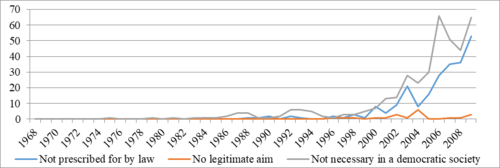
126
Figure 35 shows the number of cases in which a violation of Article 8 ECHR was established per category per year. The percentages of cases in which certain grounds led to the establishment of a violation of the right to privacy are relatively stable. The necessity-requirement has almost always been the most frequent ground, followed closely by the requirement of having a legal basis for the infringement. It may be pointed out that in more recent years, there seems a slightly higher percentage of cases in which a violation of the right to privacy was found on the ground that the infringement had no legal basis, but the period is too short to draw reliable conclusions on this point.
127
Figure 36 Ground on which a violation of Article 8 ECHR was found per type of privacy

128
Figure 36 shows the ground on which a violation of the right to privacy was found, divided by type of privacy. It appears that in most categories, it is the necessity requirement that led to a breach of Article 8 ECHR most commonly, but with respect to locational privacy, around half of the cases in which a violation was established were due to the fact that the infringement had no legitimate basis, and with respect to informational privacy, this is true for almost 4/5 of the cases. A typical example of the first is when the private home of an individual is entered without a warrant and of the second is when the correspondence of a prisoner is monitored by prison authorities without a legal basis. Finally, it should be noted that the cases in which a violation of Article 8 ECHR was found because the infringement served no legitimate aim regarded almost exclusively economical privacy.
129
Figure 37 Ground on which a violation of Article 8 ECHR was found per type of applicant
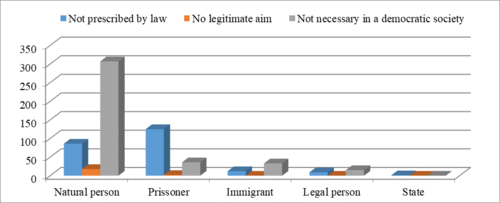
130
Figure 37 shows the reason for establishing a privacy violation divided per type of applicant. Figure 38 does the same with respect to the five countries against which most cases have been assessed by the Court (second-tier). With respect to prisoners, a violation of Article 8 ECHR is mostly established on the ground that the infringement was not prescribed for by law. Poland is the country against which these types of cases are most commonly established. Turkey is also involved in a number of these cases, as well as in cases in which it had destroyed or evacuated towns. The ECtHR has found a violation of Article 8 ECHR in these types of cases typically because no legal basis was found or because these actions served no legitimate aim.
131
Figure 38 Ground on which a violation of Article 8 ECHR was found per country
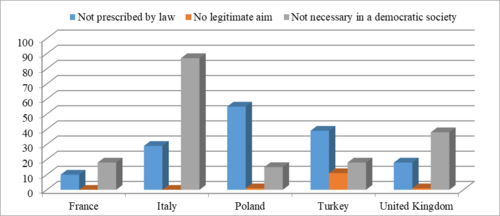
132
Figure 39 shows the total amount of damages awarded by the ECtHR in cases in which a violation of Article 8 ECHR was found, divided per category. It seems that when the ECtHR finds that an infringement has no legal basis, it will provide a larger sum of damages than in other cases. This, however, is slightly misleading. In fact, this number is influenced by a few cases against Turkey, discussed earlier. In most cases in which a violation was found on this point, no or very low sums of damages were awarded. The Court found a violation of Article 8 ECHR in only 68 of the some 230 cases because the infringement was not prescribed by law has the Court granted more than € 3.000,- for either material or immaterial damages or in the combination category. Of the slightly more than 230 cases in this category, in almost 90, the ECtHR granted no damages in either one of these three categories.
133
Figure 39 Total amount of damage awarded per category
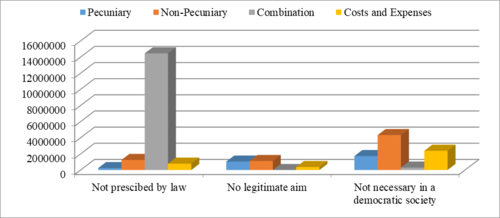
134
In fact, it seems that on average, the Court affords most damages to applicants if no legitimate aim was found for the infringement of Article 8 ECHR. But again, these are quite exceptional cases and moreover, the number of cases is rather small, so that no reliable conclusions can be drawn on this point. With respect to the necessity-requirement, it appears that especially quite considerable amounts are offered to applicants for the relief of non-pecuniary damages.
135
Figure 40 Average amount of damage awarded per case in which a violation of a requirement was found
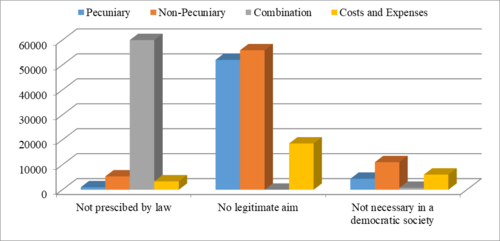
136
In this final substantial section, the reasons for finding a violation of Article 8 of the European Convention on Human Rights have been analysed. An infringement on the right to privacy (paragraph 1 of Article 8 ECHR) will be considered a violation if it is not prescribed by law, if it does not serve one of the legitimate aims listed in the second paragraph of Article 8 ECHR, or when the infringement cannot be deemed necessary in a democratic society. As shown in section 9.2, each condition has its own set of particularities.
-
Prescribed by law: this requirement seems to have become more important in recent years. An analysis of the case law of the Court on the right to privacy between 2010 and now must show whether these numbers are incidental or are part of a bigger trend. On average, relatively high amounts of damages are awarded to victims of privacy violations where the violation was found because of the lack of a legal basis. Still, this is due to a relatively small amount of cases where exceptionally high damages were awarded. In fact, in a most cases falling in this category, no or rather small sums of damages were awarded. Poland is the champion of infringing upon the right to privacy without a legal basis. There is a relatively high number of prisoners that are successful in claiming their right to privacy on this point. Moreover, the category of privacy that is mostly at stake when there is a problem with the legal basis is informational privacy. These three elements must be seen in relation to each other, because they revolve around cases in which the communication of Polish prisoners is monitored without a legal basis. Although Poland has been convicted for such behaviour a number of times, it apparently did not change its behaviour. In addition, with respect to a violation of locational privacy, the ECtHR often finds that there is no legal basis. Presumably, this is because the conditions specified in law, such as obtaining a warrant before entering the private domain of a citizen, were ignored.
-
Legitimate aim: this requirement plays no role of significance in the jurisprudence of the European Court of Human Rights. It only finds a violation of the right to privacy on the basis of this ground in a handful of cases. Consequently, the conclusions gained from the results section must be approached with caution. What can be said is that, in general, relatively high amounts of damages are awarded for violations of privacy in this category. Turkey is involved with violations of Article 8 ECHR found in this category almost without exception; it mostly involves the aspect of economical privacy.
-
Necessary in a democratic society: this requirement is the broadest and also the ground on the basis of which most violations of the right to privacy under the European Convention on Human Rights is found. Still, relatively small amounts of damages are awarded in this category on average. Italy and the United Kingdom are found in violation of this specific principle the most. With respect to the U.K., one explanation could be that the European Court of Human Rights has generally been hesitant to accept limitations on sexual freedom and a restrictive approach towards medical-ethical issues. The Court finds that a privacy infringement was not necessary in a democratic society in particular in relation to economical privacy, relational privacy, and the protection of one’s bodily and psychological integrity.
137
This contribution has analysed the judgements delivered by the European Court of Human Rights on the point of Article 8 ECHR until 2010. It has tried to paint a broader picture with respect to the types of cases before the ECtHR, but has focused in particular on the question of how the Court calculates the damages afforded to the victims of a privacy violation. The ten most important findings of this study are:
-
Most damages have been awarded in the Combination category, which consists primarily of material damages, but also of immaterial damages or financial compensation for costs and expenses made by the victims during their legal procedure. This is remarkable because the Combination category is used in a very limited number of cases. These are typically cases in which Turkey has engaged in gross human rights violations, for example by evicting people from their villages for a year.
-
There are clusters of cases to be made, which can be useful for further research. A cluster could be cases in which Poland is involved, the claimant is a prisoner, the type of privacy complained is informational privacy, and a violation is found because of the absence of a legal basis. Another may be cases with respect to the United Kingdom, involving ordinary natural persons, in which their bodily or psychological integrity is at stake and in which an infringement was not deemed necessary in a democratic society. A final example of such a cluster may be cases in which Turkey was involved, and natural persons invoked their economical privacy, a violation of the right to privacy was found because there was no legal basis or no legitimate aim involved and very high sums of damages were rewarded by the European Court of Human Rights.
-
Of the 648 cases in which the Court has found a violation of Article 8 ECHR, it awarded some type of relief in 564 of them, or in 440 of them, when the mere procedural costs (the awards for costs and expenses) are excluded. In almost 400 cases, the Court has awarded relief for non-pecuniary damages and in a similar number of cases, it has compensated the costs and expenses of the applicants. The damages awarded are usually relatively small figures. Per case in which a violation of the right to privacy was found, on average, € 4.632,- was awarded for pecuniary damage, € 10.323,- for non-pecuniary damage, € 22.773,- for a combination of categories, and € 5442,- for costs and expenses.
-
The total number of cases has increased exponentially over the years and from 2000 onwards, the ECtHR has held a violation of Article 8 ECHR in a significantly higher percentage of the cases before it. Consequently, the majority of the damage that has been awarded by the Court was granted in the last decennium. The non-pecuniary damage awarded per case has steadily but slowly increased over time. Perhaps more remarkable is that the costs and expenses awarded by the Court on average per case has dropped in the last decennium. It is unclear why. From the comparison between the last two decennia studied for this contribution, 1990-2000 and 2000-2010, it appears that the categories of pecuniary damage and of the combination of damages are communicating vessels. When the pecuniary damages are high, the combination category is relatively low and vice versa.
-
If the 5 countries are analysed against which the most cases under Article 8 ECHR were assessed by the European Court of Human Rights (second tier), it appears that a significant difference arises. While Poland is the country, which is held in violation of Article 8 ECHR most often after Italy, it is required to pay only minimal damages. Italy is primarily required to compensate non-pecuniary damages, while the United Kingdom has to pay quite significant amounts for both material and immaterial damages and for the costs and expenses. Turkey is the champion on the point of both material and immaterial costs, and in particular the ‘Combination’ category.
-
It appears that the Fourth section of the Court has in particular dealt with the cases in which the ‘Combination’ category was used. Apart from that, it is clear that especially the First and the Second section and the Grand Chamber attribute higher sums for immaterial damage than the other chambers. It also appears that the Third and Fifth section, as opposed to some other sections, have a quite even spread across the Pecuniary, Non-Pecuniary and Costs and Expenses categories.
-
When one applicant was involved with a complaint, on average, € 896,- was awarded for Pecuniary damages per case in which a violation of the right to privacy was established, € 5.906,- for Non-Pecuniary damages, € 5.488,- in the ‘Combination’ category, and €4.004,- for Costs and Expenses. When two applicants lodged a complaint, which resulted in a violation of Article 8 ECHR, this was on average € 8.385,- for Pecuniary and € 12.374,- for Non-Pecuniary damage, € 3.989,- for the ‘Combination’ category, and € 8.705,- for Cost and Expenses. These sums are for the applicants jointly and should consequently be divided by two to calculate the average amount of damages awarded per victim. The more applicants join in a case, on average, the more damage is awarded, which was to be expected.
-
Most damages have been awarded to ordinary natural persons. What is interesting is that on average, prisoners and immigrants have been awarded limited amounts of damages. This is because in a number of cases, the ECtHR stresses that the establishment of a violation in itself constitutes sufficient satisfaction for the applicant, for example, by holding that an immigrant should not be extradited or that a prisoner should have more liberties, for example, with respect to family visits. With regard to legal persons, one could have expected that especially the pecuniary damages and the ‘combination’ category would be high, but the opposite is true.
-
It should not come as a surprise that most damages have been awarded for a violation of economical privacy. Judging from the amount of damages awarded in the other four categories, it seems that the Court is inclined to provide higher sums of damages for a violation of a person’s bodily or psychological integrity and for an infringement on the privacy of his home than for a violation of relational or informational privacy. Out of the 89 cases in which the ECtHR found a violation of Article 8 ECHR with respect to bodily and psychological integrity, in 20 it provided no relief for damages or compensated only the legal costs in the Costs and Expenses category; for relational privacy, this was 60 out of 218 cases; for informational privacy, this was 73 out of 176; for locational privacy, this was 10 out of 44; and finally, for economical privacy this was 45 out of 120 cases. Consequently, the explanation is presumably that with respect to relational privacy, the ECtHR does provide damages, but only small sums.
-
Finally, it seems the case that when the ECtHR finds that an infringement has no legal basis, it will provide a larger sum of damages than in other cases. This number is, however, inflated by a few cases against Turkey, discussed earlier. In fact, in most cases in which a violation was found on this point, no or very low sums of damages were awarded. Only in 68 of the some 230 cases in which the Court found a violation of Article 8 ECHR because the infringement was not prescribed by law, has the Court granted more than € 3.000,- for either material or immaterial damages or in the combination category. Of the slightly more than 230 cases in this category, in almost 90, the ECtHR granted no damages in either one of these three categories. In fact, it seems that on average, the Court affords most damages to applicants if no legitimate aim was found for the infringement of Article 8 ECHR. But these are quite exceptional cases and moreover, the number is so small that no reliable conclusions can be drawn on this point. With respect to the necessity-requirement, it appears that quite considerable amounts are offered to applicants for the relief of non-pecuniary damages.
138
To conclude, this research has been a first enquiry into the way the ECtHR calculates damages afforded to victims of a privacy violation. It is based on the first results of a preliminary database of the jurisprudence of the ECtHR. It should be expanded further to include the cases after 2010. It could be equally interesting to include the cases on the admissibility of complaints under Article 8 ECHR (first-tier). Some additional factors could in time be developed, determining for example the type of interest that is relied on by the state or the way in which the Court reaches its conclusion. [61] It can also be the basis for comparative research, for example between Europe and the United States of America. Little comparative empirical data is available on privacy regulation on both sides of the Atlantic, so that reality and myth, fact and fiction, often go hand in hand and broad and vague contrast (‘in Europe, privacy is protected by the state, in America, privacy protects citizens from the state’, ‘in Europe, privacy is dignity-based, in America, it is freedom-based’ and ‘in Europe, privacy is a human right, in America, it is a contractual freedom’), can be posed without a reality check.
139
This article has focused on the damages afforded. The reason is that recent literature and jurisprudence on privacy is especially focused on which types of interests the right to privacy should protect, which types of harms should be afforded damages in court cases, and whether in the Big Data era, individual harm can be taken as the corner stone of privacy case law at all. This article has done the opposite from what most other scholars have done; instead of focusing on the values privacy is said to protect, it starts with the end – the damages afforded in privacy cases, and rolls back from there. Although obviously, the damages awarded in cases in which a privacy violation is established is not the same as the values privacy protects, it can be taken as indicative all the same. The article has also done the opposite of most scholars, in that it has avoided normative speculations and interpretations, instead relying on empirical data. Obviously, subjective choices and normative decisions are also made when categorizing data, but there has been no agenda or specific hypothesis in mind when designing the database. It has taken a data-driven approach and has provided limited interpretation of the data – rather, it has remained mainly descriptive and explanatory in nature. It is up to the reader and other scholars to take these data and figures further and develop what they might say about the various normative debates.
* Bart van der Sloot is a Senior Researcher at the Tilburg Institute for Law, Technology, and Society (TILT), Tilburg University, Netherlands.
[1] The standard work on harm: J. Feinberg, ‘Harm to Others’, Oxford University Press, Oxford, 1984. J. Feinberg, ‘Offense to Others’, Oxford University Press, Oxford, 1985. J. Feinberg, ‘Harm to self’, Oxford University Press, Oxford, 1986. J. Feinberg, ‘Harmless Wrongdoing’, Oxford University Press, Oxford, 1988.
[2] B. van der Sloot, ‘Privacy as virtue’, Intersentia, Alphen aan de Rijn, 2017.
[4] This article is the first output which will result in a book; the explicit goal is to gather comments and suggestions on the approach, methodology and results that are produced. The database is still preliminary and may contain marginal errors, which will nevertheless unlikely have a substantial impact on the figures featured.
[5] J. Q. Whitman, ‘The Two Western Cultures of Privacy: Dignity Versus Liberty’ (2004) 113 The Yale Law Journal.
[6] P. M. Schwartz & D. Solove, ‘Reconciling Personal Information in the United States and European Union’, California Law Review, 102, 2013.
[7] B. van der Sloot, ‘Privacy as human flourishing: could a shift towards virtue ethics strengthen privacy protection in the age of Big Data?’, JIPITEC, 2014-3, p. 230-244.
[11] B. van der Sloot, ‘Privacy as personality right: why the ECtHR’s focus on ulterior interests might prove indispensable in the age of Big Data’, Utrecht Journal of International and European Law, 2015-80, p. 25-50.
[12] Especially applied in mass surveillance cases: http://www.echr.coe.int/Documents/FS_Mass_surveillance_ENG.pdf .
[13] B. van der Sloot, ‘How to assess privacy violations in the age of Big Data? Analysing the three different tests developed by the ECtHR and adding for a fourth one’, Information & Communication Technology Law, 2015-1, p. 74-103.
[14] Fair Balance: Proportionality, Subsidiarity and Primarity in the European Convention on Human Rights’,
[15] G. Lautenbach, ‘The rule of law concept in the case law of the European Court of human rights’, Universiteit van Amsterdam, 2012.
[16] See in comparison: http://ysu.am/files/Davit_Melkonyan-1415702096-.pdf .
[17] Article 33 ECHR.
[18] Article 34 ECHR.
[19] See for the original Convention http://www.echr.coe.int/Documents/ .
[23] http://www.coe.int/en/web ; http://www.coe.int/en/web/ ; http://www.coe.int/en ; http://www.coe.int/en ; http://www.coe.int/en/web/ ; http://www.coe.int .
[24] Article 37 ECHR.
[25] On friendly settlements, see Article 39 ECHR.
[26] Even with regard to these cases, some of them have been submitted to the Grand Chamber and repealed.
[27] J. Habermas, ‘Theorie des kommunikativen Handelns’, Frankfurt am Main, Suhrkamp Verlag, 1981.
[28] ECtHR, Bogomolova v. Russia, application no. 13812/09, 20 June 2017.
[29] Article 35(3)(a) ECHR.
[30] See for example: ECtHR, Pihl v. Sweden, application no. 7472/14, 07 February 2017.
[31] ECtHR, Pretty v. the United Kingdom, application no. 2346/02, 29 April 2002.
[32] Article 30 ECHR.
[33] Rule 26 of the Rules of the Court.
[35] Article 15 ECHR.
[36] Robertson, vol. 2, p. 270.
[37] Robertson, vol. 1, p. 160-162
[38] Protocol No. 9 to the Convention for the Protection of Human Rights and Fundamental Freedoms Rome, 6.XI.1990. Protocol No. 11 to the Convention for the Protection of Human Rights and Fundamental Freedoms, restructuring the control machinery established thereby. Strasbourg, 11.V.1994.
[39] See already: B. van der Sloot, ‘Privacy in the Post-NSA Era: Time for a Fundamental Revision?’, JIPITEC, 2014, 3.
[40] Rule 60 of the Rules of the Court. http://www.echr.coe.int/Documents/Rules_Court_ENG.pdf .
[41] Rules of the Court, p. 61.
[42] Rules of the Court, p. 61.
[43] Rules of the Court, p. 62.
[44] The Euro is the currency introduced by the European Union, not by the Council of Europe. Moreover, some EU countries have decided not to join the Euro.
[46] € 1 = £ 0,7734 - € 1 = $ 1,1005 - € 1 = 9.35332 SEK - € 1 = 1.09362 CHF - € 1 = 4,2995 Polish Zloty.
[47] See for example: ECtHR, L. v. Lithuania, application no. 27527/03, 11 September 2007.
[48] Human Rights and Human Dignity: An Appeal to Separate the Conjoined Twins’, Ethical Theory and Moral Practice, June 2012, Volume 15, Issue 3.
[49] Article 35(1) ECHR.
[50] Article 35(3)(b) ECHR.
[51] See on this point: B. van der Sloot, ‘Privacy as Personality Right: Why the ECtHR’s Focus on Ulterior Interests Might Prove Indispensable in the Age of “Big Data”’, Utrecht Journal of International and European Law, 2015.
[52] ECtHR, Arvelo Apont v. the Netherlands, application no. 28770/05, 3 November 2011, § 53.
[53] ECmHR, X. v. Iceland, application no. 6825/74, 18 May 1976.
[54] B. van der Sloot, ‘Privacy as human flourishing: could a shift towards virtue ethics strengthen privacy protection in the age of Big Data?’, JIPITEC, 2014-3.
[55] The Court usually categorizes homosexual relations under ‘private life’ and heterosexual relations ones under ‘family life’.
[56] First Protocol to the European Convention on Human Rights.
[58] A recent case is: ECtHR, Zakharov v. Russia, applicaiton no. 47143/06, 04 December 2015.
[60] C. Ovey & R. C. A. White, “European Convention on Human Rights”, Oxford, OUP, 2002, p. 209.
[61] See also: B. van der Sloot, ‘How to assess privacy violations in the age of Big Data? Analysing the three different tests developed by the ECtHR and adding for a fourth one’, Information & Communications Technology Law Volume 24, 2015.
Fulltext ¶
-
 Volltext als PDF
(
Size
1.2 MB
)
Volltext als PDF
(
Size
1.2 MB
)
License ¶
Any party may pass on this Work by electronic means and make it available for download under the terms and conditions of the Digital Peer Publishing License. The text of the license may be accessed and retrieved at http://www.dipp.nrw.de/lizenzen/dppl/dppl/DPPL_v2_en_06-2004.html.
Recommended citation ¶
Bart van der Sloot, Where is the Harm in a Privacy Violation? Calculating the Damages Afforded in Privacy Cases by the European Court of Human Rights, 8 (2017) JIPITEC 322 para 1.
Please provide the exact URL and date of your last visit when citing this article.


